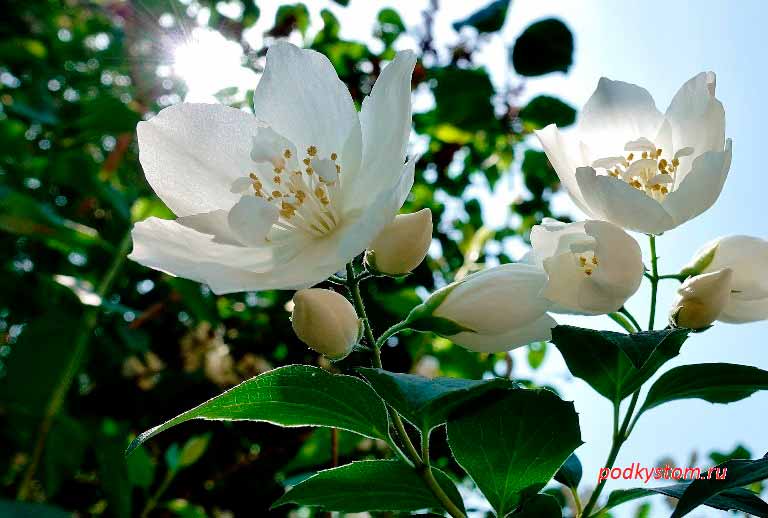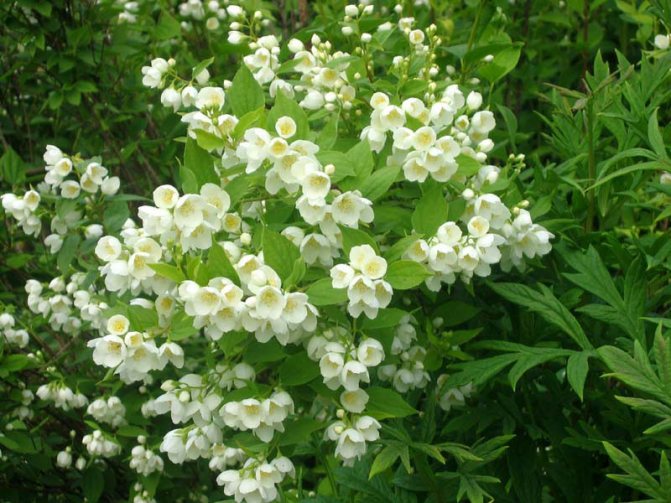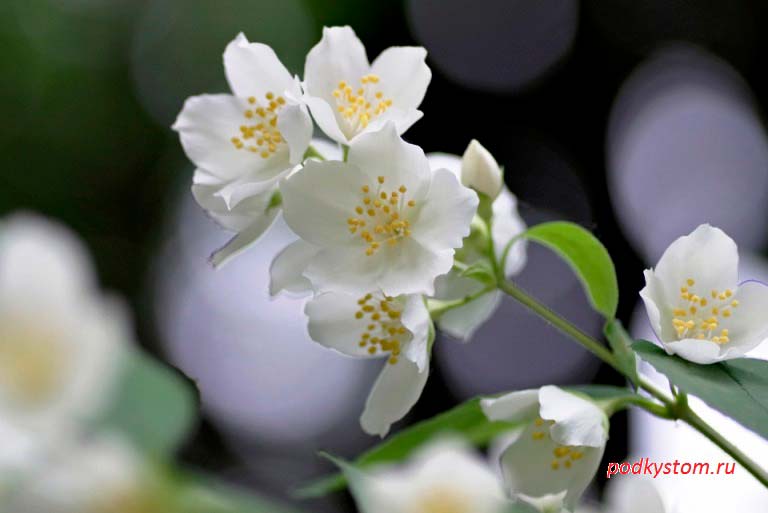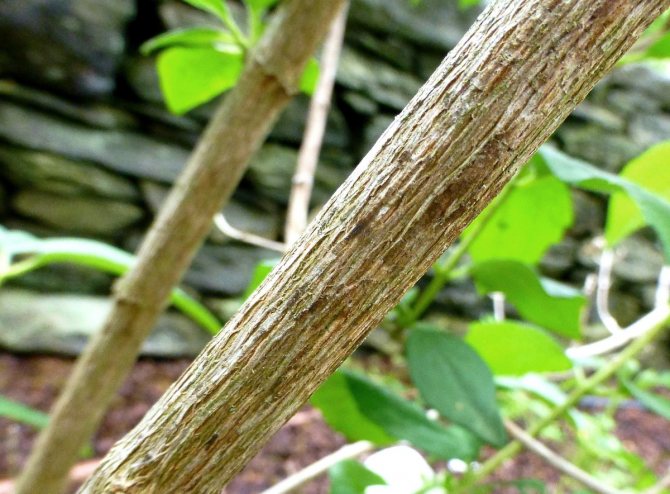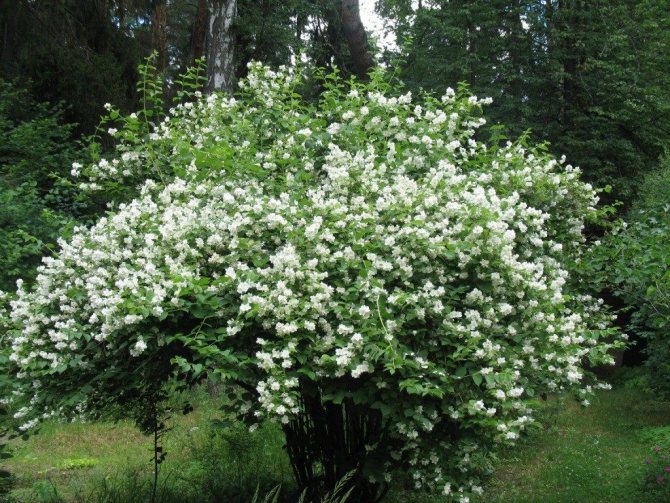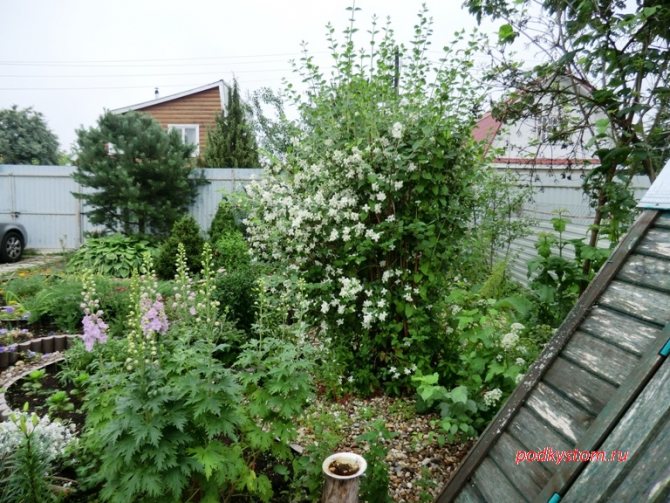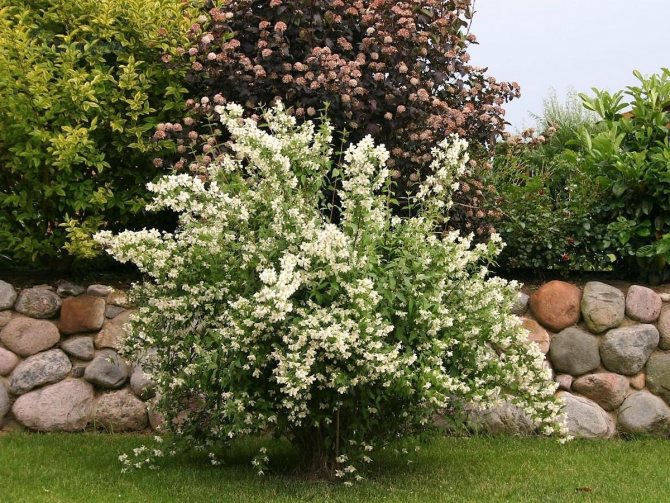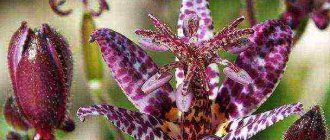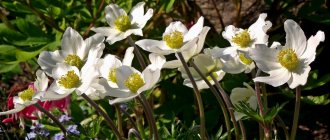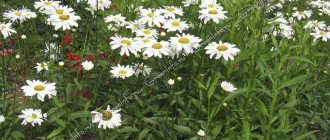Chubushnik (Philadelphus) is also called garden jasmine. It is directly related to the genus of semi-deciduous and deciduous shrubs, which are representatives of the hydrangea family. This shrub is called jasmine, because the flowers of such plants are very similar in appearance and also have the same pleasant aroma. Chubushnik-Philadelphus was so named in Latin in honor of the king of Egypt, Ptolemy Philadelphus. Chubushnik is called him due to the fact that shanks and mouthpieces for pipes intended for smoking were made from sufficiently strong wood with a soft core. Under natural conditions, such a plant can be found in Europe, North America, and also in East Asia. In nature, there are 50–70 species of chubushnik, but in culture there are many varieties of such a shrub.
Description of the plant
As mentioned above, some gardeners mistakenly call the mock jasmine. This is not the same thing and the description of the characteristics of the above plants is completely different. The only thing that reminds jasmine in the mock-orange is that the flower of the plant has a pronounced sweet aroma. Otherwise, this shrub has multiple straight trunks of various thicknesses with a thin gray bark that tends to flake off. They can grow up to three meters in height and form a dense, rounded crown. The shrub has hanging branches with a slight bend. The wood of the plant is solid, has a wide core, which served as raw material for the manufacture of shafts and mouthpieces in pipes for smoking. It is thanks to this that the shrub got its name. Its leaves are simple, oppositely located, ovoid-pointed, light green in color, can reach a length of nine centimeters.
Chubushnik ordinary forms flowers at the ends of small young shoots, they are collected in brushes, sometimes consisting of nine, but more often three to five pieces. The plant blooms in June, and this period lasts no more than three weeks. The flower of various varieties of mock-orange can have a simple, double and semi-double structure. Then the fruit appears - a box having from three to five faces, and filled with flat, rather small seeds.
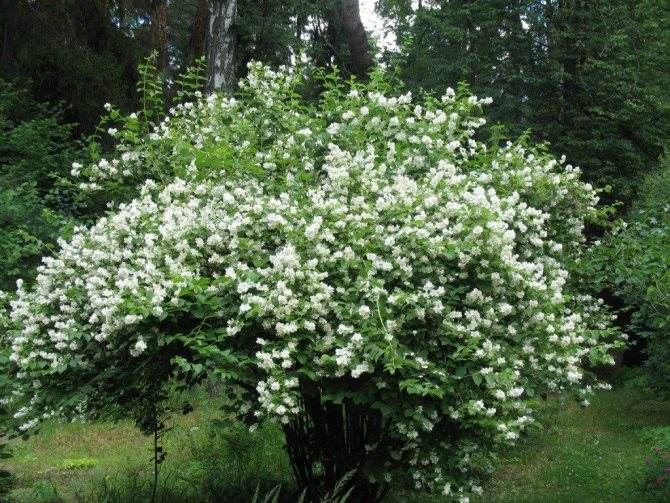
This shrub is frost-hardy, at too low temperatures the ends of young shoots can freeze slightly, but the presence of a well-developed root system contributes to the rapid recovery of the plant. Chubushnik loves the sun, but can put up with a little partial shade. It has no special requirements for the soil, does not like salinity and stagnant water. Drought tolerant. It takes root well in urban conditions. Wind resistant. This allows it to be used not only as a garden shrub, but also for urban landscaping.
Choosing a site for planting and preparing a nutrient substrate
The procedure for planting seedlings consists of several stages:
- Seat selection and pit preparation.
- Seedling preparation.
- Transfer.
- Follow-up care.
Before planting a chubushnik, gardeners inspect the territory of the site and determine a suitable place. It should be well lit, on level ground or on a sloping hill, but not in a lowland. It is better to plant in a corner protected from the wind so that the crown does not deform under the influence of strong wind gusts.
When transplanting 2-3-year-old bushes, the depth of the planting pit should be from 50 to 60 cm, and the width should be no more than 65-70 cm.To avoid stagnant water, the bottom is sprinkled with a drainage composition: small river pebbles, cork chips, broken brick, vermiculite or other granular substance.
The bottom must pass moisture well, the recommended drainage height is 15 cm.
To prevent the fertile soil from falling into the drainage cracks, the first layer is sprinkled with coarse sand (about 2-5 cm). Despite the fact that adult bushes grow on any soil, young seedlings need additional groundbait for better rooting. In this regard, a layer of peat (15 cm) is poured into the pit with the addition of complex fertilizer.
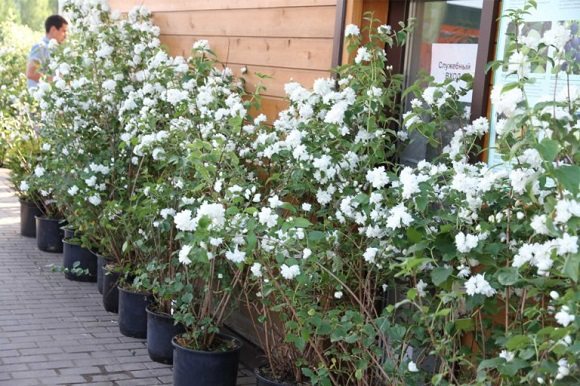

Garden soil is poured over the nutrient cushion. It should be noted that the soils near Moscow are considered depleted and do not contain enough nutrients. Experienced gardeners recommend pouring ready-made soil mixture for the garden into the holes. It is sold in most gardening shops.
After cooking, the pit is left for a couple of hours for weathering and oxygenation. A damaged root system will need it for speedy regeneration.
Growing
There are several ways to propagate this garden shrub:
- seeds;
- layering;
- using a cutting;
- root suckers;
- dividing the bush.
How to grow a mock-orange from seeds, a description of the technique. Chubushnik seeds remain viable for one year and can be sown in autumn, winter and spring. For storage, they must be placed in a glass container and in a cool room. Preliminary stratification is not needed for chubushnik seeds. For sowing in winter, you need to choose calm weather and a temperature of at least ten degrees of frost. The seeds are placed in the thickness of the snow to a depth of at least twenty five to thirty centimeters, in the ridges prepared in advance. The sowing site is covered with straw or small branches, and then pressed with larger branches. For the winter season, the seeding rate is two and a half grams of seed per square meter. When spring comes, the branches are carefully removed, and the hatched seedlings are shaded. If there is a spring planting, then it is carried out in greenhouses or greenhouses, at the rate of seed material from half a gram to a gram per square meter. In the future, it is important to monitor the optimal humidity and shade the area. After the emergence of shoots, they must be irrigated every other day with a weak solution of potassium permanganate, and after six to twelve days, dive. If you take care of the seedlings enough, they will quickly get stronger and by autumn they will grow to twenty-twenty-five centimeters.
Reproduction by cutting. With the help of cuttings and daughter layers, mainly varietal chubushniks are propagated. The most favorable time for their rooting is early spring. The greatest preference for this is given to light soils with a sandy loam composition. For the cutting, holes are made in the ground, where it is placed obliquely, to a depth of two upper buds. Rooting usually occurs after three to five weeks. Toward the end of summer, a fibrous root is formed at the cuttings. In order for the roots to develop better, they must be hilled from the period when the growth of the shoots begins. All summer long, the soil must be loosened, watered and get rid of weeds. In the second season, the ground part of the grown cutting is cut to obtain a "stump", which stimulates the growth of bushy growth. And already in the fall, the formed plant can be transferred to the place allotted to it.
In the second and last decade of June, the reproduction of the mock-orange can be performed using a green cuttings taken from strong shoots. Immediately after cutting the cuttings, the leaves must be cut in half. The optimal length of a cutting, containing one internode and two pairs of leaves, does not exceed five centimeters. The bottom cut must be made oblique, and the top cut should be slightly higher than the top knot.Planting such cuttings should be carried out in greenhouses.
Reproduction by layering. To grow a mock-orange by layering, an adult mother bush must be prepared a year before breeding. All its shoots are cut to the ground in such a way that stumps remain at a height of three to five centimeters, which stimulates the emergence of annual growth. In early spring, when the buds have not yet blossomed, these shoots are bent down on well-dug and leveled soil. Thus, an adult bush can give up to forty allocated shoots. Each such layer can form several new shoots, developing from existing buds and growing upward. By autumn, their height reaches fifteen centimeters. For another two years, young plants grown from cuttings grow stronger in the garden, and after that they can be planted in a place of constant growth.


Shelter for the winter
Young plants need winter shelter. For these purposes, straw or spruce branches are used. Sometimes only snow cover is enough for wintering. To do this, the bushes are bent to the ground even before the leaves fall, since later the branches will be fragile. If the snow has not completely covered the bush, it should be added until a sufficient covering layer is obtained.
Powerful adult bushes do not need shelter. Sometimes shoots can freeze slightly (especially in varieties with colored and variegated leaves). After spring pruning, they recover quickly.
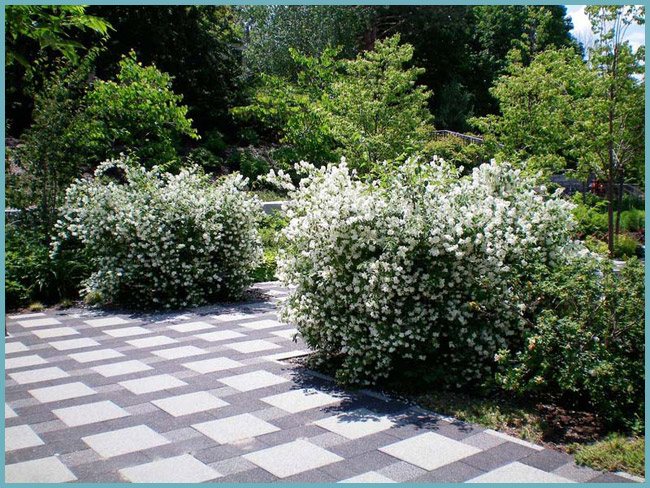

Chubushnik in landscape design
Landing features
In order to grow this garden shrub without hassle, you need to deliberately choose the place where to plant it. Preference is given to fertile soils with good moisture and drainage. It should be borne in mind that stagnant water and the close passage of groundwater can be detrimental to these plants. It is advisable to drain the pit into which the plant will be planted well with sand and gravel, and sprinkle it on top with a mixture made up of leafy soil, mature humus and ordinary sand, taken in a ratio of 3: 2: 1.
The depth of immersion of seedlings in the ground should not exceed sixty centimeters, while the root collar cannot be immersed more than three centimeters, in order to avoid decay. The root system of the chubushnik reliably holds the earthen lump and accepts the transplant well.
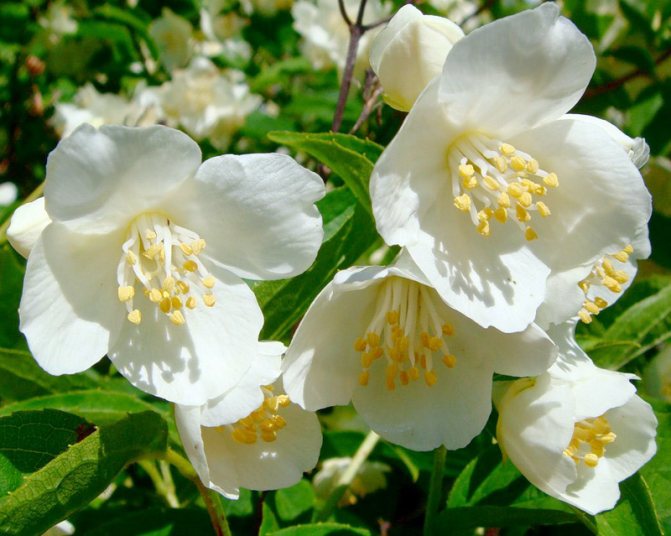

Benefits of Garden Jasmine
When preparing for transplanting, gardeners take into account factors such as the degree of need for moisture, lighting and bait, frost resistance, winter hardiness, growth rate, type of root system, as well as the strength and flexibility of the branches.
Chubushnik has the following characteristics:
- Average light-requiring. The shrub tolerates partial shade, but produces smaller inflorescences with insufficient light.
- Fear of waterlogging. The root system does not rot at high groundwater levels, but it can deteriorate during long stagnation of moisture in the hole.
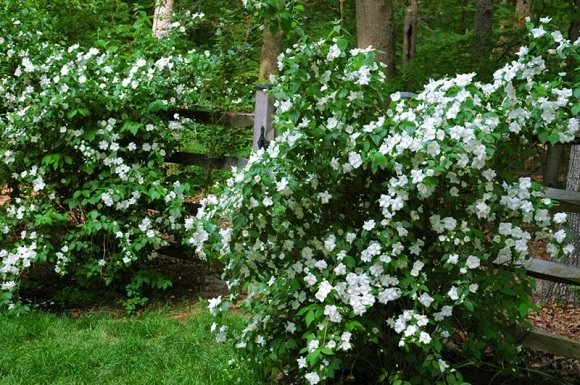

The above criteria will help you navigate when choosing a landing site.
Care rules
Caring for a chubushnik consists of several mandatory points.
- Chubushnik bushes are recommended to be fertilized annually with manure. Slurry, diluted at a concentration of one in ten, in the amount of one bucket is the required dose for each bush. Two years after planting, the mineral composition must be added: fifteen grams of potassium sulfate, the same amount of urea and thirty grams of superphosphate must be diluted in ten liters of water. Use on one or two plants. At the end of flowering, 20-30 grams of phosphorus fertilizer and up to 15 grams of potassium sulfate are given for each square meter, wood ash can be used in an amount of no more than 100-150 grams.
- Chubushnik needs good watering. With a prolonged lack of moisture, the leaves of the bush lose their elasticity, but quickly recover when watering, as well as after rains.In the middle of summer, the shrub needs water at the rate of twenty to thirty liters per square meter of the trunk circle. Planting a mock-orange is completed with watering in the amount of at least one bucket per bush.
- During the summer months, it is necessary to look after the root circle and loosen the soil to a depth of at least five centimeters. It will be enough to do this two or three times, while removing the weeds. For mulching, peat or earth is used in a layer of three to four centimeters.
- Pruning a chubushnik is an important component of care. In early spring, formative pruning of the shrub is carried out, which makes it possible to correct its shape. For this, the strong branches are cut slightly, and the weak ones are cut off strongly, which contributes to the active growth of young annual shoots.
- Every two to three years, rejuvenating pruning is performed when dying shoots older than twelve years are removed. This contributes to the rejuvenation of the crown, more active growth and rich flowering of the shrub.
- The plant tolerates frost well, so most of its varieties do not need winter shelter. Sometimes, with too intense frosts, the peripheral areas of annual shoots can be damaged. By removing them in the spring, you can quickly restore the crown and flowering.
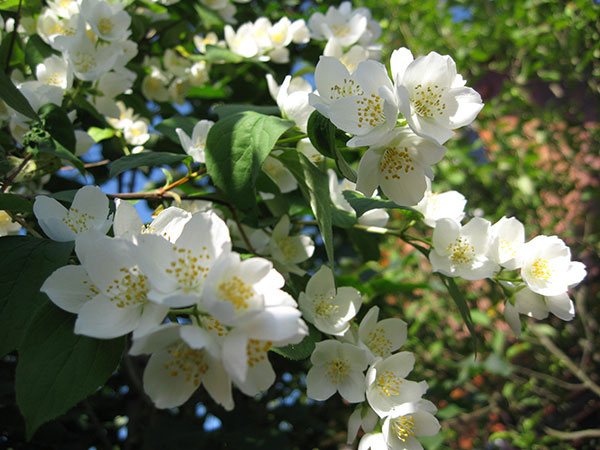

Chubushnik is resistant to diseases and most pests. When a plant is weakened due to poor-quality care, its leaf plates can be affected by spider mites, bean aphids and leaf weevils.
Diseases and pests
Chubushnik is quite resistant to disease. Of the pests, the plant is affected:
- spider mite;
- aphids;
- leaf weevil.
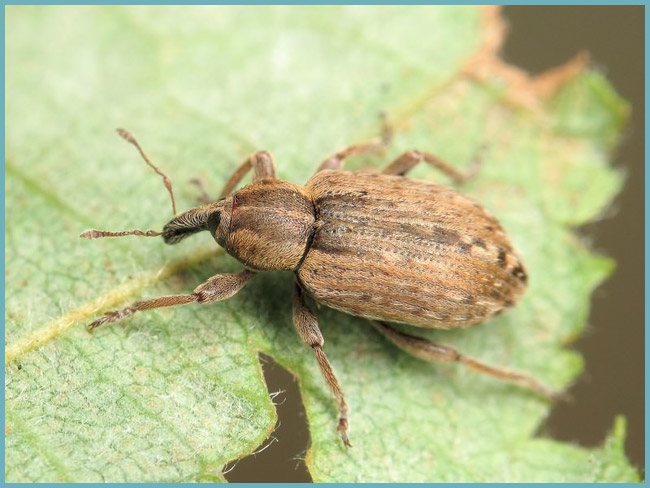

Leaf weevil
For pest control, both industrial preparations (Fitoverm, Bitoxibacillus, etc.) and folk remedies are used. Against aphids, an infusion of potato green tops, tobacco, and yarrow is used.
Chubushnik: growing and care in the open field.
Although the mock orange has no botanical relation to genuine jasmine, for all inhabitants of the climate with harsh winters, it is he who is associated with jasmine. This is the real king among the garden shrubs that are widespread in our gardens. It "earned" such a status by its unpretentiousness, durability, and the beauty of flowering. Chubushniki are one of the easiest flowering shrubs to grow. You will not find a spectacle equal to them in landscape, gentle and romantic beauty in the summer garden. Of course, garden jasmine has competitors, but this does not prevent it from being an inimitable favorite.
What to plant next?
Chubushnik is unpretentious not only in care, but also in the neighborhood. Many perennials and most annuals get along with him. Depending on the variety and shape of the crown, such undersized crops as cinquefoil, alder cage, cistus can be planted around the bush.
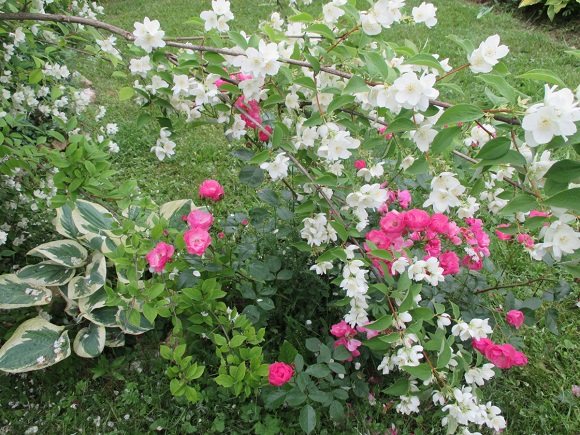

To know what to plant next to the mock-orange, you need to focus on its varieties and parameters. Treelike chubushniks up to 3-4 m in height look beautiful in a frame of such medium-sized perennials as calicant, herbaceous peonies, lilies, hydrangeas, as well as plants, the crown of which resembles a ball.
Dwarf garden jasmines up to 1 m in height are planted around such plants as zamaniha, lespedeza, hibiscus, quince and tree peonies. In southern latitudes, shrubs are combined in plant compositions with real jasmine. The vines of the latter are allowed to curl along the lattice supports, against the background of which dwarf bushes are placed. Whichever neighbor is chosen for planting, the composition will turn out worthy of attention.
Common mock-orange, it is also called crown mock-orange (garden jasmine) belongs to the genus of shrubs and the Hortensiev family. In our country, this plant is mistakenly called jasmine, which is due to the fact that the flower of some types of mock-orange has a sweet rich aroma.This deciduous shrub is widespread in Europe, eastern Asia and most parts of North America. Within the Russian Federation, it can be found in the Far East region and the Caucasus.
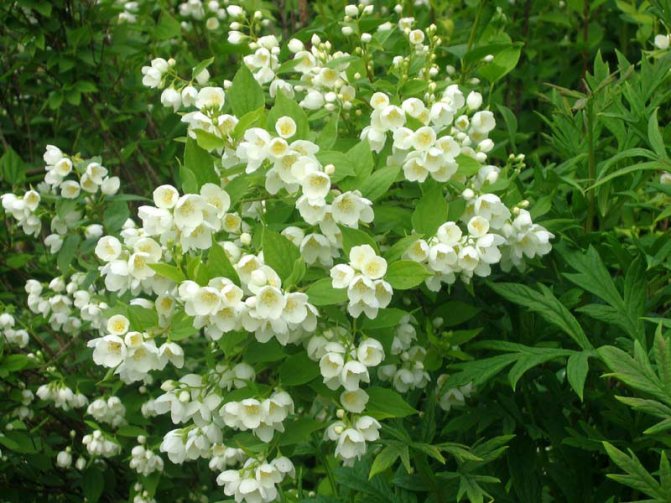

Description of the plant
Chubushnik (Philadelphus) is a genus of decorative flowering deciduous shrubs belonging to the Hortensiev family. Homeland - temperate climatic zone of Europe, Asia and North America. The plant received its Latin name in honor of the Egyptian pharaoh Philadelphus, a great fan of aromatic plants. The Russian version of the name comes from the word "chubuk". This was the name of the part of the pipe for smoking, which in ancient times was made from the trunk of this culture. The hollow stems of the chubushnik are used to make flutes and pipes. Gardeners have a more common common name - "Jasmine Garden" or "False".
The genus Philadelphus has more than 70 species, several of which grow wildly in the Far East and the Caucasus. In horticulture, about 30 species have found application, represented by a variety of garden forms. Chubushnik bushes grow up to 4 m. Leaves are medium-sized, whole, ovoid. The flowers are white or creamy, clustered or solitary, often very fragrant. Varietal specimens have a double flower shape. Fruits are small multi-seeded capsules. The plant is an excellent honey plant.
In Siberia, the height of the bushes is normalized according to the level of snow cover. The plant is able to tolerate frost and air pollution. From year to year, at the beginning of summer, the mock-orange looks like a bride, covered with a "veil" of delicate white flowers. At the same time, the entire garden is filled with an enchanting aroma. In one place, the bushes have been growing for more than ten years.
Pests and diseases
Most of the pests that threaten the plant in warm climates do not survive in Siberia. There is a spider mite, they get rid of it with Fitoverm. Less often, the leaf weevil parasitizes, and insects are destroyed with the chemical "Bitoxibacillin".
The only infection affecting mock-orange in Siberia is brown spot. The growth of the fungus occurs at the end of July, manifests itself in small dark brown spots with a white border on the lower part of the leaves. At the first signs of infection, the damaged areas are removed, the leaves, after falling off, are collected and burned. The shrub is treated with copper-based preparations.
Planting and proper care
Despite the general undemanding and unpretentious care of this species, in order for the plant to become a real decoration of your garden, it is recommended to create the most favorable conditions for its growth and development. The developed basic recommendations will become practical help in organizing the proper care of the crown mock-orange:
seat selection
Given the durability and size of an adult shrub, the choice of a planting site must be approached in advance and carefully. Chubushnik grows equally effectively both in open space and in partial shade, but the quality and duration of the flowering period directly depend on the lighting - in sunny areas the bush blooms longer and the inflorescences are larger;
soil composition
In general, the plant is not demanding on soils, the only limitation is that it does not tolerate soil salinization and wetlands. In heavy clay areas, it is advisable to arrange drainage. It is capable of fully manifesting all its decorative qualities on almost any cultivated soils, therefore, it is recommended to improve the soil with organic matter or compost before planting;
It takes root equally effectively in both spring and autumn planting. The roots of the seedling are placed in a small hole (depth and diameter up to 50 cm) along the root collar and covered with fertilized soil. The ground around the planted shrub is compacted, then watered abundantly;
After the end of planting, regardless of the season, it is necessary to shorten the main branches by a third and completely cut off the weak shoots.Subsequently, annual pruning is carried out after the end of the flowering period. Underdeveloped branches are cut out and at the same time a bushy crown is formed. If the shrub is frozen in winter, it is necessary to carry out sanitary pruning in early spring;
watering and feeding
In the first year after planting, the plant needs regular watering, and then as needed, depending on weather conditions. It is advisable to apply top dressing or mineral fertilizers twice a year - in early spring and after flowering. You can apply complex mineral fertilizers diluted with water with irrigation, in the presence of organic matter - prepare slurry and water with diluted water in a ratio of 1 to 10 solution.
Thus, the crown mock-orange, being an unpretentious ornamental shrub, needs only timely thinning, periodic watering and removal of weeds from the near-trunk space. Planting and care is quite simple, does not require excessive efforts and a lot of time, reproduction also does not cause much trouble.
Pruning
Two-, three-year-old seedlings are pruned to form a crown. Depending on the preferences of the gardener, the chubushnik bushes form high or squat. In the spring and after flowering, sanitary pruning is carried out, removing frozen, old, growing inward, weak shoots and faded inflorescences. Thickened bushes are thinned out.


Pruning is very useful for renewing shrubbery.
For rejuvenation, the bushes are cut at the root, leaving only a few powerful shoots for renewal.
Reproduction of chubushnik
Chubushnik is propagated by dividing the roots or, during the flowering period, by cuttings with young green bark. They are planted in a place specially prepared for them. They take root longer.
Also, the mock-orange can be propagated by seeds, but the bushes will bloom no earlier than 5 or 8 years later. The seeds can be planted in autumn and spring, and even in winter - in prepared furrows in the snow. Such a planting is usually covered with straw or dry branches, and removed when spring arrives. The sprouts that appear are covered from the direct sun, but do not isolate from the sunlight at all. In the fall, they are sown in the prepared ridge, such as garlic. In the spring, they are usually sown in greenhouses, but first they saturate the seeds with moisture, like many seedlings:
- in a nylon sock, dipped into water to start the germination process;
- then placed in sawdust or another similar substance that retains moisture;
- the swollen seeds are dried and planted, adding a little sand and manure.
There are three methods of breeding a chubushnik are used:
Many people propagate shrubs with seeds that sprout quickly but are very small in size. To preserve small sprouts, they must be grown in greenhouses. Only when the sprouts reach twenty centimeters can they be planted in the beds. But in your permanent home, the shrub must be settled already in the second or third year of life. Seed propagation is effective but time consuming. In winter, you can practice shrub propagation by cuttings. To do this, the stalk must be placed in a protected location, such as a basement. During the winter, the stalk grows stronger and grows, in the spring it is planted in the soil to enrich it with nutrients. Layers. For vegetative reproduction, it is necessary to take young healthy shoots, they need to be cut off in the winter, and harvested in the fall. It is necessary to choose not thick shoots with a delicate coating, they must be young and fresh.
7sotok.by
Chubushnik (garden jasmine) is a beautiful tall shrub with spreading branches, from which it is impossible to look away. The shrub is distinguished by a large number of varieties and species. The most basic and common types of garden jasmine include: lemoine, crown, terry.In order for a fragrant-sweet shrub with rich flowers to please the eye, it must be properly planted, tenderly looked after, and know the features of reproduction.
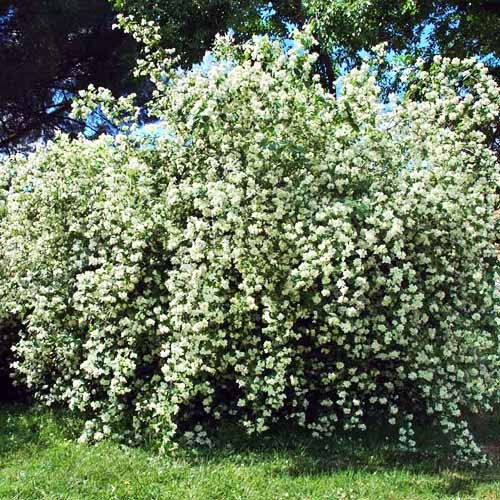

Features of the plant.
Garden jasmine stands out among the variety of all plants for its individual structure. The stem of the fragrant shrub has a brown-brown color, the bark is cracked, the height of the jasmine reaches 4 meters. In the spring, the color of the garden jasmine leaf is characterized by a pale green tint, in the fall the leaves are transformed into a bright lime color. The size of the leaves of the plant is quite large.
The flowers of this colorful shrub have a size not exceeding 5 cm in diameter, grow as an inflorescence in the form of a brush, stand out in creamy white shades. The flowering time of garden jasmine depends on its type, but the flowering period of most plants falls in late spring and lasts until mid-summer.
Chubushnik and its historical roots.
They knew about the chubushnik bush in ancient times. The origins of its name come from Ancient Greece, in which the master made “shanks” for a smoking pipe from the lower stem of a plant.
Sometimes the mock-orange is called jasmine. This is due to the similarity of the notes of aroma and the very inflorescence of these two extraordinary plants. A distinctive feature is the growing conditions. Jasmine is mainly grown indoors, while mock-orange is grown outdoors in the garden. The main types of garden chubushnik.
Garden chubushnik pleases gardeners with a huge selection of varieties and species. The most popular and unpretentious types of shrubs include: Lemoine mock-orange, crown mock-orange, terry mock-mock.
Chubushnik Lemoine.
The diameter of the crown of the chubushnik lemoine shrub is 1.7 m, the maximum height is 1.5 m. The flowers are characterized by a rather large size (up to 4 cm, 3-7 flowers per cluster), rich sweet aroma, shades of white and light beige. The total flowering period is three weeks, beginning in June and ending in July.
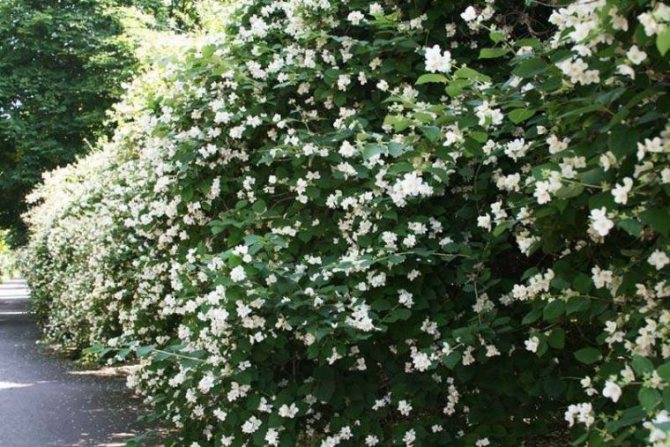

Lemoine foliage is ovoid. Variation in leaf size - 4-5 cm. In spring and summer, jasmine-lemoine leaves are painted in dark green colors, in autumn - in golden yellow. Growth indicators are characterized by an annual increase in width and height by 3-5 cm. The maximum age of the garden lemoine is reached at 25 years.
This type of chubushnik is practically not whimsical in choosing the soil in which it is planted, but the exception is salty and very wet soil. The plant loves to bathe in sunlight. If it is planted in a shaded area, it will affect the flowering rate for the worse. Prefers regularity in humidity.
It tolerates winter well enough, is characterized by frost resistance. In a harsh winter, shoots may freeze and recover quickly. The lemoine mock-root is planted in a well-lit place, the distance between the bushes should be 0.5-1.5 m, the depth for planting is 50-60 cm (the root neck deepens by 2-3 cm no more, so as not to rot).
The root system of the chubushnik holds the soil well, tolerates transplanting quite favorably. Before planting, drainage is done with a layer of 15 cm of sand and gravel. The ratio of the soil mixture: (2: 3: 1) humus, leaf earth, sand.
During care, it is worth systematically removing 4-5 old shoots. Sanitary pruning, thinning of the shrub is carried out after the flowering of the lemoine. It is worth carrying out 2-3 dressings throughout the season. Differs in stability in urban conditions. Often planted on the lawn in the form of decorative compositions (hedges, trimmed curbs).
Crown chubushnik.
The size of the crown diameter of this type of jasmine is 2 m, the maximum height is 3 m. Flowers are characterized by a fairly average size (up to 3 cm, 5-9 flowers per cluster), rich honey-sweet aroma, shades of white and cream color. The total flowering period is 1.5 weeks, beginning in July and ending in August.


The foliage of the crown mock-orange is characterized by an acute-oval shape. Leaf sizes from 4.5 to 9 cm. In the spring-summer period, jasmine leaves are painted in a matte dark green color, in the fall - in bright yellow. Growth indicators are characterized by an annual increase in width of 20-25 cm, in height of 30-40 cm. The maximum age of the crown mock-orange falls at 20 years.
This type of shrub is not whimsical in the choice of soil, but the exception is soil oversaturated with moisture. Chubushnik is very fond of light. Planting in a shaded area will result in poor flowering. Prefers regularity in moisture and a place protected from winds.
It tolerates winter well and is characterized by a high level of frost resistance. Chubushnik crown is planted in a lighted place, the distance between the bushes is 0.7-2 m, the depth for planting is 55-60 cm. Before planting, drainage from sand and gravel is being prepared. A mixture of soil: (2: 3: 1) humus, earth, sand. Do not be capricious when transplanting. Thinning and pruning of the shrub is carried out after flowering. Top dressing is carried out in March-April. Basically, the crown cube is planted to decorate the garden plot. Terry chubushnik.
The size of the diameter of the crown of the shrub is 1.3 m, the maximum height is 3 m. The flowers are medium-sized (up to 4.5 cm, the brushes are dense, 5-10 flowers each), there is a slight aroma of ordinary jasmine, the color is dominated by a white-cream color. The total flowering period is 3.5 weeks, begins blooming in early June and ends in late July.
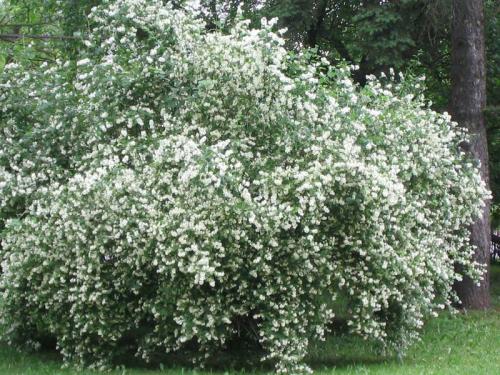

The foliage of the terry chubushnik has an ovoid toothed shape. The size of the leaf is 5 cm. The leaves of the bush are painted bright green, in autumn they are yellow. Growth rates increase each year in width and height by an average of 5 cm. The maximum age is reached at 25 years. This type of chubushnik is practically not whimsical in the choice of soil, the exception is the high moisture content of the earth. The plant loves light. Planting in the shade is not recommended as this will reduce the flowering rate.
It endures winter with complications, is characterized by high sensitivity to frost (a small shrub is wrapped up). Terry chubushnik is planted in an illuminated place, the distance between the bushes is 0.5-1.7 cm, the planting depth is 50 cm. Drainage for this type of jasmine is made of sand and gravel. Care consists of regular pruning and thinning. Top dressing is carried out several times a season. Used in decorating garden plots.
Garden jasmine has a large number of other types. It is worth paying attention to a detailed examination of the planting, care, reproduction of the chubushnik.
Landing.
Initially, you should choose a site for planting a plant. If the place is shaded, then the flowers of the shrub will be small, and the shoots will stretch out strongly in height. An open, well-lit place will be great. With a low level of water permeability of the soil at the landing site, it is worth making drainage (mix sand and crushed stone).
The optimal composition for planting a garden mock-orange is the ratio of leaf earth, sand, humus (3: 2: 1). The most favorable time of the year for planting chubushnik is autumn (mid-September - mid-October). In the springtime, jasmine can also be planted, but it is worth doing this before the buds open on the trees.
When planting several chubushnik bushes at the same time, the distance of the holes should be from 50 to 100 cm, taking into account the peculiarities of the size of an adult bush. If the purpose of planting a chubushnik is to acquire a "fence-plant", then the seedlings when planting have a distance of 50-70 cm from each other. The root system is immersed in the prepared hole so that the root collar is level with the surface of the site. Further, the pit with the root is covered with fertile soil. Reproduction.
There are four ways to reproduce a mock-orange: shoots, cuttings, dividing a bush, seeds.
Reproduction of the chubushnik using the escape.In spring or autumn, shoots are cut from the bush and placed in moist soil until the root system is formed. Next, the place where the sprouted shoots are planted is determined in accordance with the planting rules.
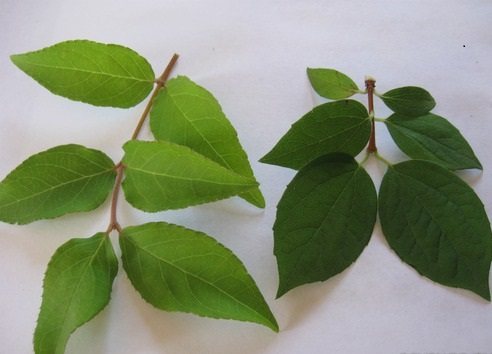

Reproduction of a mock-orange by cuttings. A young twig breaks off with a sharp movement from the main shoot. It should have a small piece of bark wood. To root the cutting, drainage, peat, sand, a cap and a container are needed. One-year or two-year-old cuttings no higher than 50 cm are selected. A drainage layer lies at the bottom of the container, moistened sand and peat are on top of the drainage. The next layer of sand is 2.5 cm, which is watered with a fungicide solution. Cuttings are planted at an inclination of 35 degrees and covered with a cap prepared earlier. To accelerate growth, cuttings are sprayed daily with water.


Reproduction of the chubushnik by dividing the bush. It is the fastest way to grow a plant. The most optimal period for this type of reproduction of garden jasmine is autumn (October). If the procedure is carried out in the summer, then it should be done before the flowering of the plant or after (excluded during flowering).
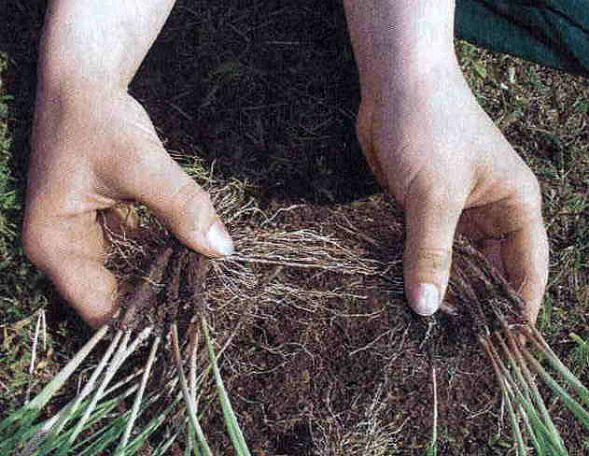

First, carefully dig up the bush so as not to injure the root system. Next, carefully with scissors for the garden, the bush with the root is divided into several bushes, which are planted in the soil prepared according to all the planting rules. For the rapid development and strengthening of the root system, the plant should be planted in a well-lit area.
Reproduction of the garden chubushnik by seeds. A type of breeding that takes place in early spring. Before that, a greenhouse or greenhouse is built, containers with a nutrient mixture of peat, sand, humus. To accelerate germination, the seeds of the mock-orange are placed in a nylon bag and dipped in water at room temperature for 2 hours.
Further, for swelling, the bags are placed in sawdust or wet peat for 2 days. Then it is dried and laid out on paper, mixed with sand and sown into prepared grooves. Finally, the surface of the soil is crushed with peat. After strengthening the shoots, they are planted from the greenhouse in the open ground. Care.
Chubushnik garden refers to unpretentious plants. But despite this, every plant needs care and maintenance. The care procedure is not complicated. For an adult bush, the lion's share of care is carried out in early spring, until the complete exit from winter dormancy. The soil is loosened around the root system and sprinkled with peat, humus.
For all types of garden jasmine, pruning is very useful (in place of old branches, young and healthy ones are formed). With pruning shears or garden shears at the very bottom of the bush, very tall, old branches are cut (which, if not removed, will spoil the shape and aesthetic appearance of the plant).
In the summer, the procedure for caring for a flowering mock-orange consists of watering. Since almost all types of garden chubushnik are frost-resistant, they do not require special care in winter. The exceptions are several types, which should be wrapped up a little with special material. Timely weeding is necessary.
A good fertilizer for garden jasmine is a mixture of water and manure (10: 1 ratio). After the bush fades, it is fed with ash from the wood. If the plant is properly planted, carefully looked after, then it will delight the eye with light-saturated colors of flowers and a delicate aroma.


Pests. Weevils, aphids, spider mites are among the main pests of garden jasmine. Weevils and their larvae feed on the juice from the mock-orange leaf. If the summer is rainy enough, then aphids can appear on the tops of the young bush, which will harm growth. Often, jasmine branches are enveloped in cobwebs by a tick. To avoid trouble with these pests, the plant should be treated with a carbophos solution.
If individual branches are damaged, the chubushnik can be saved by washing a mixture of water and laundry soap. You can protect the plant from spider mites and aphids with the help of burdock infusion (2 kg of burdock is poured into 10 liters of water, infused for 10 hours, filtered). The damaged chubushnik is processed three times after 5 days. An infusion of mustard helps from the weevil (100 g of dry mustard are poured into 10 liters of water, let it brew for 48 hours). The plant is processed three times after three days.
Preparation for wintering
In the autumn, when the plant has faded, thinning and sanitary pruning is carried out. Chubushnik is fed with potassium-phosphorus fertilizer, and the surface of the soil around the bush is sprinkled with a rather thick layer of mulch (sawdust or peat).
You do not need to cover the shrub for the winter. If some shoots are damaged by severe frost, then after pruning in the spring, the bush will grow again. In winter, there is no need to care for the shrub.
Most of the natural species of chubushnik, and there are about 50 of them, are representatives of the temperate zone, although no more than 4–5 are found in large numbers in Russian gardens. Despite the abundance of flowering varietal material, semi-wild plants with small simple flowers adequately occupy their niche and are in no hurry to give it up. Among their advantages are natural endurance and vitality, adaptability to cold climates, annual and long flowering, rich aroma.
- Common mock-orange is a multi-stemmed, vigorous shrub, in its adult form forms a spreading fountain 3-4 m high. It opens the flowering period of garden jasmines. The flowers are simple, white with a light cream shade, fragrant. Among the advantages of the species is winter hardiness (up to -25⁰ C). The genotype of the plant formed the basis for many varieties, the first of which was the Virginian or Virginian mock-orange.
- Ch. Large-flowered came to Russia more than two hundred years ago. As the name suggests, the main advantage is the large snow-white flowers, although the aroma is weaker than that of C. ordinary. It will bloom two weeks later, but the outfit does not drop for almost a month.
- Ch. Fluffy is unusual with a narrow crown shape with vertically growing shoots. The flowers are medium-sized, with a faint aroma, more bell-shaped in shape than others. Differs in an abundance of inflorescences located not only at the top, but also along the entire length of the shoots of past years. Blooms almost all of July.
- Chubushnik is a wreath, a welcome guest in the gardens of the Moscow region, where it is more often represented by dwarf and variegated forms. In its natural form, it is also good - slender, spreading, the flowers are quite large (up to ø4.5 cm), with a creamy shade, they smell delicious. Withstands low temperatures (-25⁰C), in case of freezing, quickly recovers.
- Small-leaved - a low (up to 1.5 m) shrub, during flowering completely covered with small flowers smelling of strawberries with notes of pineapple. It formed the basis of many Lemoine varieties.
Note! Sometimes Lemoine's chubushniki are distinguished as a separate species. This is a group of varieties and hybrids bred by the French company Lemoine on the basis of wild plants - Ch. Ordinary, small-leaved, etc. It is represented by a large assortment with double and semi-double flowers.
Popular varieties
From the foreign selection of chubushnik, such popular varieties and hybrids can be distinguished:
- Alabaster - famous for its large double fragrant snow-white flowers, collected in inflorescences up to 50 cm long. The bush branches are rigid, 1.5-2 m tall.
- Belle Etual - a two-color variety. The flowers are small, white, pink at the base, with a subtle unobtrusive scent of jasmine. The bushes are compact.


Bel Etoile variety
- Airborne assault - under the weight of numerous simple cream flowers, the branches of the bush droop. Strawberry aroma.
- Aurea - differs in bright yellow foliage. Flowers are small, solitary, cream.
- Avalanche - medium-sized shrub with weeping branches. It blooms very profusely with white simple smallish flowers with a strawberry aroma.
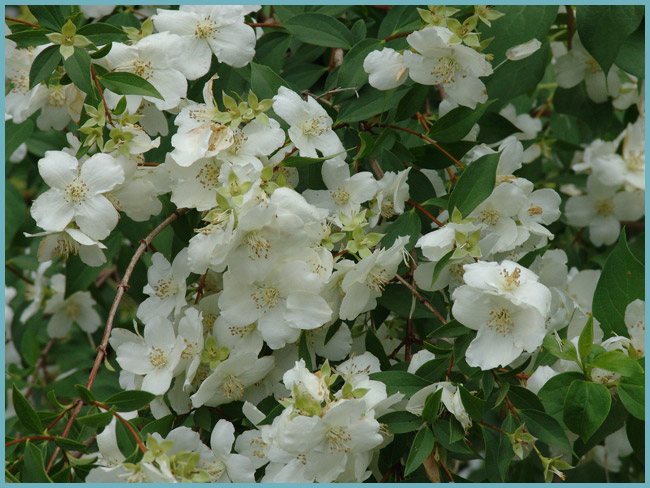

Avalanche variety
An invaluable contribution was made by N.V. Vekhov. The varieties bred and multiplied by him adorn botanical gardens and florist sites throughout Russia.
- Academician Komarov - a low branchy bush with very large snow-white semi-double flowers with a subtle, barely perceptible aroma.
- blizzard - the height of the bush is about 1 m. The crown is branched. Terry flowers, dense inflorescences. The flowers cover the bush very densely, forming a snow-white blanket.
- Pompon - small double snow-white flowers are collected in spherical inflorescences, resembling pompons in shape. The bush is compact, the aroma is weak.
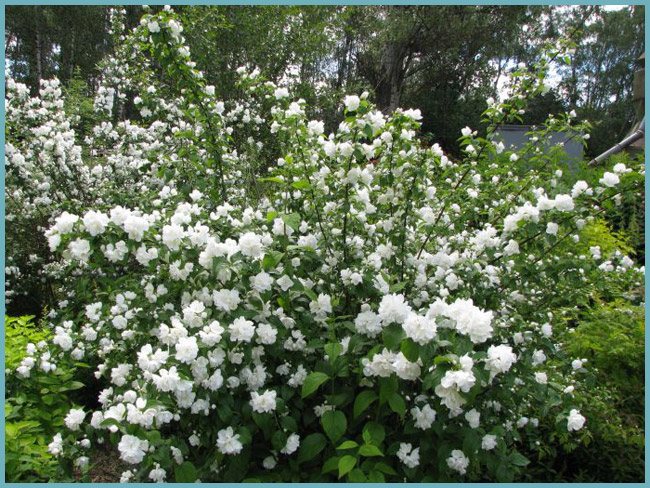

Pompon variety
- Pearl - stems are reddish, spreading, curved, about a meter high. The flowers are snow-white, densely double.
- Gnome - a dwarf bush with a domed crown and small yellowish leaves. Does not bloom. Used to decorate green borders.
The use of chubushniki in design and the best partners
In the design of the garden, chubushniks are used:
- as one of the main landscape and romantic shrubs;
- as the main summer flowering shrub;
- as a soloist against the background of undersized compositions and lawns;
- as a background plant;
- as a visual center of blooming compositions;
- in mixborders;
- in classic flower beds with a play of height;
- in front gardens and parterre plantings;
- in the design of rockeries, alpine slides, reservoirs and water bodies (undersized varieties);
- in a regular style (non-flowering varieties "Gnome" and "Dwarf" look like green buttons and trimmed spheres);
- to create hedges (both monospecific and complex, landscape and strict);
- for decorating resting places and near terraces, gazebos, pergolas as a fragrant and picturesque accent;
- to mask unsightly areas and communications;
- to create voluminous "wild" compositions;
- in ensembles with a continuous flowering relay.
The best partners for chubushnikov: all flowering shrubs from spirea and weigela to scumpia, ornamental apple, lilac and hydrangea, woody with an unusual crown and decorative leaves (maples, turf, hazel). In flower beds and ridges, it is perfectly combined with decorative deciduous and beautifully flowering perennials and annuals.
Seedling preparation and planting work
Chubushnik tolerates both primary and subsequent transplants well. Both young plants and adult trees take root in the new place. The optimal age for planting garden jasmines is from 2 to 3 years.
Before planting the bushes in open ground, they are pre-prepared and pruned. The root system is sprayed or sprinkled with root formation stimulants, and the crown is treated with a weak solution of manganese. Lateral shoots are cut off completely, and the top of the crown is cut by a third. This procedure stimulates abundant tillering and rooting of the chubushnik.
The best time for a transplant is early evening or morning hours. Fragile seedlings, falling under the scorching sun, wither and shed their foliage. Aggressive direct rays cause burns to leaves and buds. In this regard, it is recommended to shade the seedlings in the first week after planting.
Video with recommendations from an experienced gardener.
During transplantation, the bush is placed in the center, dripped with garden soil. It is recommended to plant shrubs at a distance of 1.5 m, dwarf varieties - 0.8 m. The plant does not need additional supports or soil mulching. Saplings are spilled abundantly with water as the hole dries, but not more often than 1 time per day.
Use in landscape design
Chubushnik is planted both in single plantings and in groups. It looks beautiful in combination with other ornamental shrubs (rose hips, lilacs), roses and conifers. Chubushnik is effective in the background of a flower bed with perennials. Low-growing and dwarf varieties are planted in rockeries and rock gardens, as a tapeworm on the lawn, as well as in artificial reservoirs.Chubushnik bushes are used for the construction of hedges. Chubushnik is also popular when landscaping city streets and parks.
The unusually beautiful flowering and pleasant aroma of the mock-orange made it a favorite among gardeners, especially since it is quite easy to grow it.
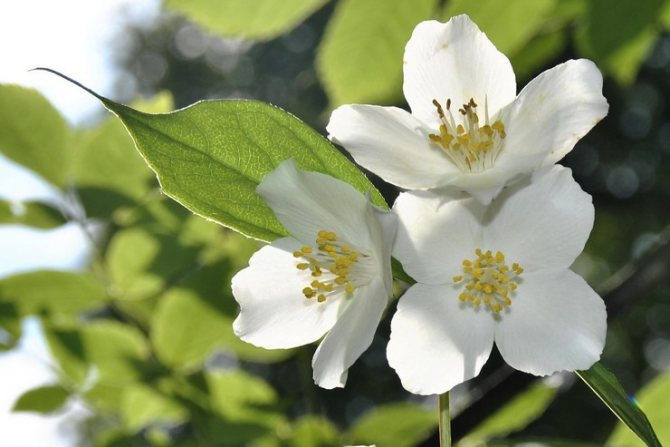

Chubushnik (Philadelphus) is popularly called garden jasmine. This shrub is one of the representatives of the genus of deciduous plants that belong to the Hortensia family. Due to the pleasant and sweetish scent of flowers, as well as the similarity of the structure of the buds, it is compared to jasmine.
The origin of the name Philadelphus chubushnik is associated with the Egyptian ruler Ptolemy Philadelphus. Previously, from durable wood, plants were made of shafts and mouthpieces, which were used for smoking pipes. In the wild, the shrub grows in North America, Europe and East Asia. In the botanical literature, there are about 50-70 varieties of mock-orange.
Planting a garden chubushnik and subsequent care
Chubushnik (garden jasmine) is an unpretentious frost-resistant plant suitable for growing in most regions of Russia. The most popular species are crown, odorless, large-flowered, small-leaved. On their basis, breeders bred various varieties: from dwarf (Dwarf, Dwarf, Yunnat) to tree-like (Ballet of moths, Airborne landing, Snow avalanche).
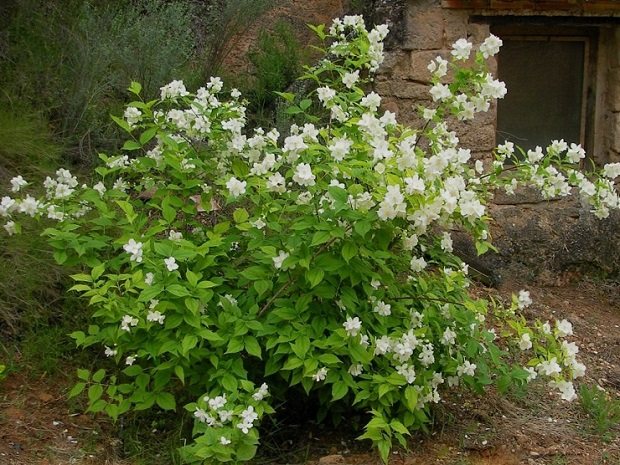

Many gardeners mistakenly consider this shrub to be a type of jasmine. However, the latter belongs to the Olive family, while the chubushnik is a representative of the Hortensievs. For a mock-orange, planting and care is fundamentally different from similar procedures for jasmine. In order to choose the right place for a shrub, plant and schedule seasonal work, you need to get to know the perennial better.
Description of the chubushnik shrub
The shoots of these shrubs have a strong, tree-type cover with a wide core. The bark of young shrubs looks brown and flakes slightly. Elongated and oval leaves can grow about 2-7 cm. During flowering, the plant exudes a dizzying aroma, which are spread by terry racemose inflorescences that form at the ends of the shoots. In place of withered flowers, a seed capsule is formed, divided into several parts. Chubushnik is distinguished by frost resistance, but, in any case, this does not mean that all varieties of the Hortensiev family will behave in the same way. However, thanks to a powerful and developed root system, in the event of the death of the ground part of the plant, it will still be able to recover and start new shoots.
Chubushnik features
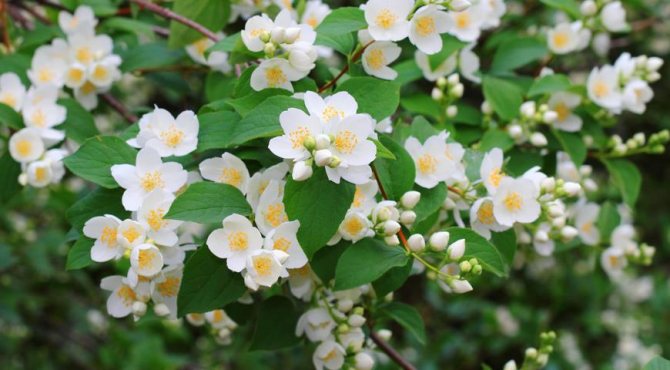

The plant has many small trunks, on the surface of which there is a gray bark, which is quite thin. In young stems, the bark is usually brown and flakes off. This shrub has very strong wood and a wide heart. The leaf plates are 2-7 centimeters long, and their shape depends on the species and can be ovoid, elongated or broadly ovate. The formation of racemose inflorescences occurs at the tops of young shoots. The flowers are fragrant and can be semi-double, simple or double. The fruit is a box with a three-pentahedral shape. There are very small seeds inside it. Such a plant is frost-resistant, but it should be borne in mind that different types of this shrub in the same climatic conditions can behave completely differently. If, due to severe frosts in winter, the chubushnik is severely damaged, then it will not die. In this case, it is recommended to completely cut off the part that is above the ground. Thanks to a well-developed root system, the plant will grow back rather quickly, and will again delight with its spectacular appearance.
Chubushnik planting
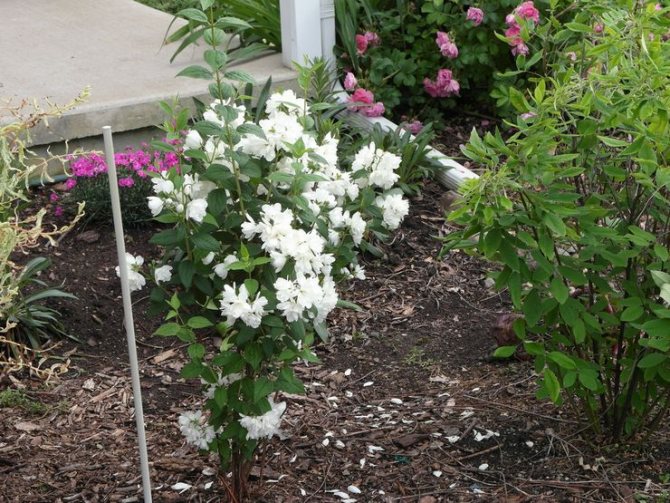

An open and lighted place is selected as a site for growing. If you plant a shrub in the shade, then the flowering will not be so lush. You can prepare the substrate for the chubushnik yourself by taking 1 part of humus, 2 parts of sand and 3 parts of garden soil. To improve the permeability of the soil, a drainage layer is added to the substrate. The optimal time for planting is considered to be the beginning or middle of autumn. If in the fall it was not possible to devote time to these events, then you can plant a mock-orange in the spring before the buds begin to open on the trees.
How to plant correctly
The depth of the bush holes dug depends on the size of the plant. To grow a hedge, it is worth placing the seedlings in such a way that the distance between them is at least 50 cm. A layer of sand is poured at the bottom of the holes, which will provide a drainage effect. After that, they are filled with soil mixture, but this must be done several weeks before planting, so that it can properly tamp. The root of the bush should be at ground level. The soil is spread around the seedling and pressed firmly. After planting, the area must be thoroughly watered. It will be enough to add 2 buckets of water under each bush. Once the surface is dry, sprinkle it with a little dry earth to retain moisture. If the root collar is very deep, then it will probably quickly begin to rot. After a few days, the bushes must be mulched with peat or sawdust.
Cultivation of chubushnik in Siberia and the Urals
The photo shows the last stage of planting a chubushnik in Siberia; for further growth, the seedling needs appropriate care, it consists in watering, feeding and pruning. All varieties recommended for temperate climates are characterized by high frost resistance; after freezing of the shoots, they quickly recover. To avoid a stressful situation, it is better to cover the plant for the winter.
Watering and feeding schedule
Chubushnik is a moisture-loving plant with a low indicator of drought resistance. Regardless of the region of growth (both in Siberia and in the South), the shrub requires constant watering. The seedlings are watered every 6 days using 5 liters of water. An adult shrub once every 15 days, the required volume of water is 15 liters. This graph is calculated taking into account the complete absence of precipitation. A sign of moisture deficiency will be the loss of turgor by the leaves, they droop, begin to turn yellow at the edges.
They begin to feed the chubushnik in the second year of the growing season. In the spring, before the formation of buds and during flowering, liquid organic matter is introduced under the root. After flowering, the trunk circle is covered with ash. At the end of August, for the better formation of flower buds, they are fed with phosphorus and potassium agents.
Loosening and mulching of the soil
The first obligatory loosening is necessary for the chubushnik during the swelling of the kidneys. Subsequent ones are carried out as the weeds grow and the soil dries out. Mulching will relieve you of unnecessary loosening, stop the growth of weeds, retain the necessary moisture and protect the root from overheating in summer. The mulch layer in Siberia is renewed every spring after the first weeding.
Pruning
In the second year of growth, the shrub will bloom with single flowers, the buds are not left. At the end of summer, the crown of the chubushnik is cut off, the shape and height are corrected, in the spring, damaged shoots are cut, as well as curved and growing inside the bush. In the third year, the plant enters a full flowering phase. After flowering, the shoots are removed completely.
For 4 years of growth, in addition to the listed activities, rejuvenating pruning is carried out: all the stems are cut off at the root, leaving 3-4 young strong shoots. The procedure is carried out in a year. With a strong thickening of the shrub, thin, old branches are removed from the central part of the shrub.
Preparing a chubushnik for winter in the Urals and Siberia
Adapted varieties of chubushnik tolerate a drop in temperature well.Taking into account that the biological species is thermophilic, it is not worth risking when growing in Siberia. If a frost shelter is not used, the instability of winter temperatures can cause the annual plant to die. The shrub is mulched, the branches are pulled together with twine, and bent to the ground. Cover with dry leaves on top, cover with a snowdrift in winter. An adult mock-orange is watered abundantly, the mulch layer is increased, the branches are cut to about the level of the snow layer. In spring, the shrub will quickly recover and bloom profusely.
Chubushnik care


When a plant needs extra moisture, it sends a signal through its leaves. They become lethargic as they lose turgor pressure. If the summer is dry enough, the chubushnik may die without water. It is best to follow a regular watering regime and water the bushes once a week. As soon as the flowering period of the plant begins, the volume of moisture is almost doubled. Wet soil must be loosened and weeds removed. However, if it is mulched, then this will save you unnecessary trouble.
Chubushnik accepts feeding with organic fertilizers well. Such a top dressing is added in the spring once a season for each adult mock-orange bush. Faded bushes are also treated with wood ash. It is scattered before watering along the near-stem circle of the plant. Chubushnik, which has reached the age of four, is allowed to be fed with solutions of complex mineral fertilizers. To feed 2 bushes, it is enough to dilute 30 g of superphosphate, 15 g of urea and 15 g of potassium sulfate in a bucket of water. If potassium is not at hand, it can be replaced with wood ash. Top dressing with nitrogen fertilizers is carried out exclusively in the spring.
To observe the long and bright flowering of the mock-orange from year to year, the bushes must be periodically trimmed. Lush inflorescences are formed only on large shoots, while thin and fragile branches are capable of producing rare flowers. For this reason, chubushnik bushes often look unkempt. To maintain the shape and visual appeal, after the end of flowering, it is necessary to prune the faded branches, which has a positive effect on the state of young growths. They receive more strength and nutrients and will delight you with beautiful flowering next season.
Autumn pruning at the same time allows you to free the crown of shrubs from unnecessary shoots that interfere with growth, and get rid of diseased and dry branches. Old shoots must be removed every three years. Spring pruning of bushes is carried out for the purpose of rejuvenation. The strongest trunks are shortened to 30 cm, and the rest are cut at the root. Places of cuts are smeared with garden pitch, and the area where bushes are grown is mulched with peat. With the arrival of autumn, dormant buds will begin to form strong young shoots.
Chubushnik can tolerate a transplant without any problems. Only a transplanted plant will be able to please with flowering next year. Having chosen a new site, it is necessary to prepare the holes for planting. Chubushnik bushes are pre-watered, their old shoots are cut off. After that, the excavated specimens can be transferred to another location. The plant is transplanted in mid-autumn or with the onset of spring before the buds open on the shoots.
Fertilization and feeding
Chubushnik is very responsive to fertilization. Twice a season, it is necessary to feed with slurry, and after flowering, apply wood ash under the bush.
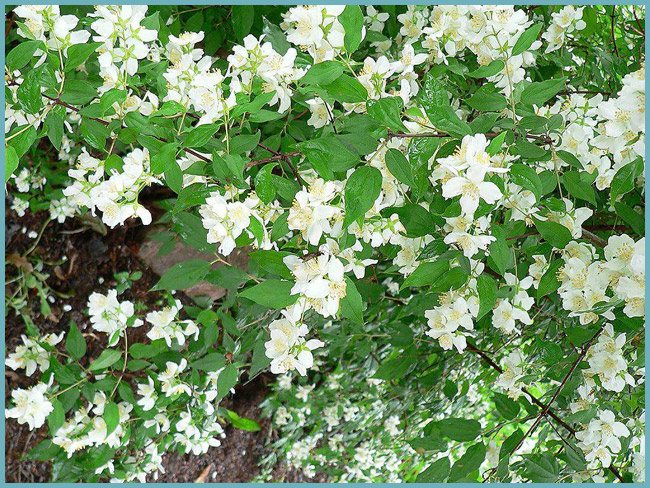

Top dressing will help the crop develop better
Three-year-old seedlings, in addition to organic matter, already need mineral fertilizers. Superphosphate, urea, potash fertilizers are used to saturate the soil with minerals. They are introduced in the form of aqueous solutions.
Reproduction of chubushnik


Reproduction of a shrub will not be difficult, so even novice gardeners can do this. The main methods are seed and vegetative cultivation of garden jasmine.The first of them may seem simpler, but in practice, a more vegetative way of reproduction of the mock-orange is used. The reason is that the seedlings are not able to fully preserve the hereditary traits.
Propagation by cuttings
Cuttings make it possible to get guaranteed rooting, therefore, when breeding a chubushnik, they are used first of all. Planting material is cut from the healthiest and strongest branches. You should not use growth shoots that have a deep core and large gaps from one bud to another. As a result, decay processes can develop in these hollow cores. For reproduction of a mock-mushroom, it is better to take green cuttings with a heel, which are called annual shoots, which retain part of last year's shoots. The cut sites must be treated with a root-forming agent. Then the cuttings are placed in containers containing a nutritious soil mixture with the addition of sand. Containers with seedlings are covered with polyethylene or glass to create the effect of a small greenhouse. Then they are left under diffused light. In the process of rooting, it is important to spray the cuttings with plenty of water.
Reproduction by layering
Their rooting rate is also quite high. Breeding with layering is necessary after anti-aging pruning. Using a soft wire, it is necessary to pull the young shoot near the base of the lower bud. After that, put it in a shallow dug trench and sprinkle it with a little earth. The next year, the layers are separated from the main bush.
Reproduction by dividing the bush
The division of the chubushnik is carried out in early spring or autumn, when the plant will shed its foliage. To do this, the bush is carefully dug up and divided into parts, each of which is promptly planted in another area.
Breeding technique
Chubushnik propagates by cuttings, layering or seeds.
Green cuttings cut during budding or flowering. To do this, you need to choose short (up to 10 cm) shoots that do not break when twisted into a ring. At the bottom of the cutting, there must be a "heel" (internode). The leaves are shortened by half.
Advice. It is better to cut the breeding material in the morning hours, when there is the maximum amount of moisture in them.
It is recommended to root cuttings in greenhouses or in covering beds. Before planting, it is worth soaking them for a day in a growth stimulator. Next, the cuttings are planted in a peat-sand mixture at a distance of 5-10 cm from each other so that the lower leaves remain on the surface. In the greenhouse, the seedlings are constantly sprayed. After about a month, the cuttings will take root. During this period, the shelter is removed, and the seedlings are grown in an open bed.
Woody cuttings cut in autumn and stored in a cool room. In the spring, they are planted in a garden bed, leaving 2-3 cm on the surface. The root system develops by autumn, and with it young shoots.


Chubushnik reproduces well by vegetative methods.
For layering choose the strongest annual shoots. In the spring, they are buried in narrow grooves, having previously made shallow cuts in the area of the first kidney or tightly pulling this place with copper wire. By autumn, the cuttings form a rhizome and young shoots, which in spring can be separated from the mother plant and planted in separate bushes.
Seeds mock orange reproduces very rarely, due to the loss of varietal qualities. Seeds are buried in the ground in autumn, covered with branches or dry grass. Sowing in winter on snow is possible. To do this, small grooves are made in the snow near the soil surface, the seeds are laid out, covered with branches and sprinkled with a layer of snow. A bush grown from seeds will bloom only after 6-8 years.
Attention! Seeds propagate only species chubushniki.
Types and varieties of chubushnik
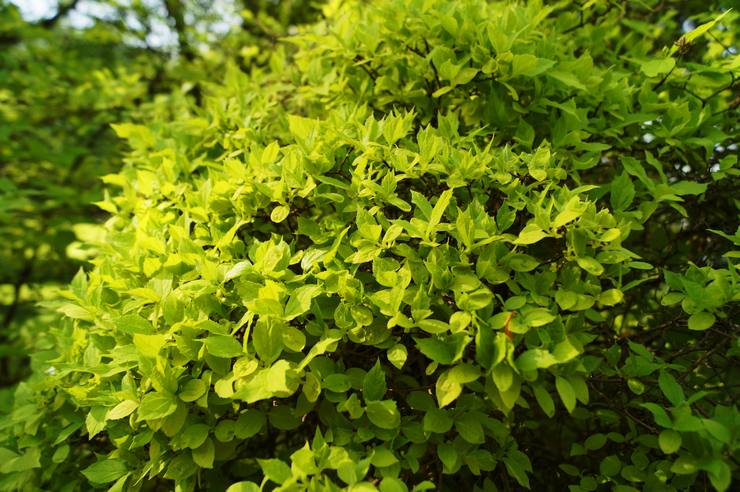

Among the cultural representatives of the chubushnik, the most common:
Common chubushnik Is a shrub that grows mainly in southwestern Europe and the Caucasus. The length of its shoots is sometimes about 3 m. The leaves are oblong-oval. The flowers are white with a cream shade and are collected in several pieces in racemose inflorescences. This variety also includes: Virginal, Belle Etoile and Bicolor.
Crown mock considered a southern European plant variety. Found in Asia Minor and southern Europe, it is distinguished by yellow or reddish-brown shoots and lush foliage. Duration of flowering is about 3 weeks. Some of the most popular varieties are: Aureus, Variegatus and Innosens.
Lemoine - This is a crossed species of small-leaved mock-orange and common mock-orange, which grows in the territory of European and North American countries. This species is characterized by large white inflorescences and long, spreading shoots. Hybrid varieties include: Ermine Mantle, Charm, Snowstorm and Glacier.
Species common in Siberia
The bloom lasts only a few weeks. The variety of species and bred varieties allows you to enjoy the delicate and fragrant flowers of this bush much longer due to different flowering periods.
Opens bloom season in Siberia thin-leaved chubushnik with white large, low-aromatic flowers. The height of the bush reaches 3 m. Young shoots are gray, covered with fine pubescence. The bark of adult branches is brown, often covered with cracks and flaking from the branches. Leaves up to 10 cm long, petiolate, ovate, sometimes slightly pubescent. The bushes bloom in June.


Chubushnik thin-leaved
Shrenk's chubushnik it has a large flower size and a strong aroma. Blooming in June, the bushes are covered with white flowers for almost a month. In horticulture, many decorative forms of various colors and structures of flowers are grown.
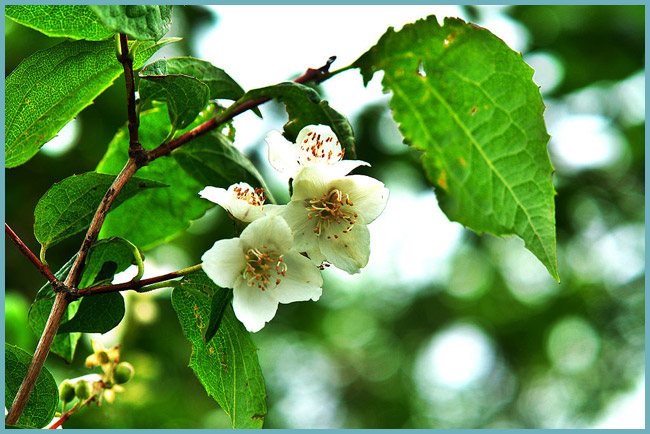

Shrenk's chubushnik
Garden forms are widespread in the south of Siberia. chubushnik Caucasian... Bushes of this species are tall (up to 3 m). Young shoots of the plant, painted in yellow or reddish color, look spectacular. The flowers are pale cream, collected in long racemose inflorescences of 7-10 pieces, very fragrant.
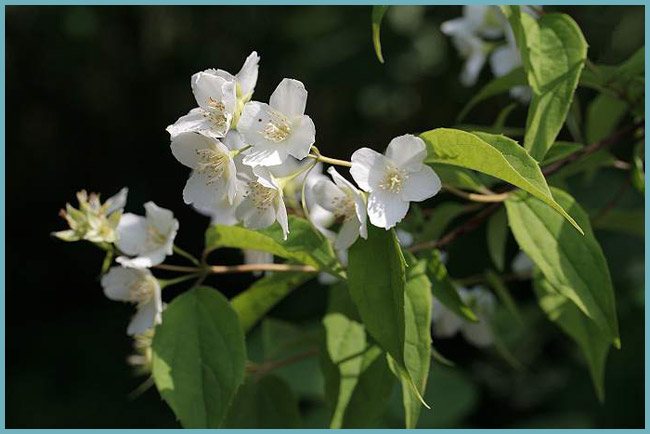

Chubushnik Caucasian
Blooms for a month from the end of June chubushnik Corona... Very persistent and widespread tall species. Flowers up to 4.5 cm in size, light beige, fragrant. Separately, it is worth highlighting the undersized non-flowering form "Nana". The height of the bushes of this form reaches only half a meter.
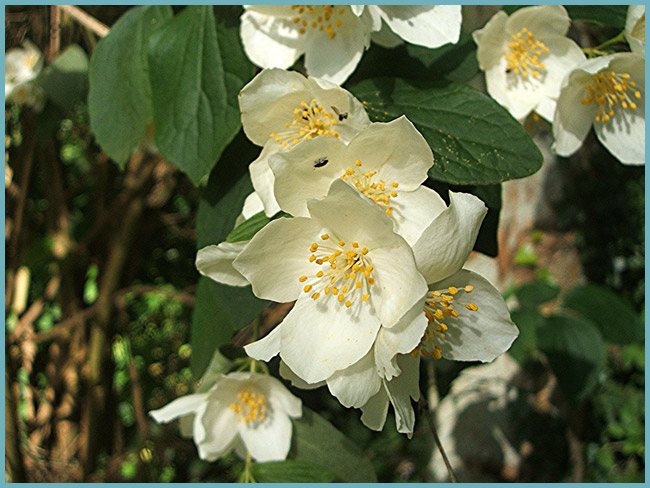

Chubushnik Coronal
From undersized species in Siberia are grown chubushnik small-leavedblooming at the end of June. The white flowers are solitary, have a sweet strawberry aroma and cover the thin branches with a solid carpet. Garden forms have double and semi-double flowers with pink, white or caramel color. Cut flowering shoots retain their decorative effect for a long time.


Chubushnik small-leaved
One of the brightest representatives of the genus in Siberian gardens is mock orange large-flowered... The name of the species speaks for itself. The size of the flowers reaches 5 cm in diameter. Low-flowered inflorescences (3-5 pieces). Odorless. The flowering period is July-August.


Chubushnik Large-flowered
The last to bloom is the most spectacular species - Lemoine's mock... This is a hybrid of an ordinary and small-leaved mock orange. The common mock-orange (or pale) itself is not grown in Siberia due to the low threshold of frost resistance. White large fragrant flowers of Lemoine bloom in July. Many garden forms and varieties are known.


Chubushnik Lemoine
Reproduction methods
Chubushnik is propagated in 4 ways.
Cuttings
This method is considered the most reliable, since the cuttings root well. Cuttings from developed shoots are cut as planting material. It is better not to use young growth, it has a hollow core that can rot.
The most effective planting material is an annual shoot with a part (base) of last year's shoot.
A cut stalk 8-10 cm long is treated with a preparation for the formation of roots and planted in a container with fertile soil to a depth of 1 cm. A glass cover helps to create conditions like in a greenhouse. They are covered with planting material. A greenhouse is also suitable for these purposes. The cuttings must be sprayed daily to speed up the rooting process, which lasts approximately two months.


Layers
To propagate garden jasmine in this way, you must select healthy plants. During the growing season, young flexible shoots, before leaves appear on them, are bent to the ground, applying a wire bundle over the lower bud at a distance of 1 cm. The stem thickens over time, roots appear on it. It is carefully sprinkled with fertile soil. A rooted shoot needs regular watering and hilling.
The young shrub should be planted in the fall. It is better to transplant it temporarily to the garden bed so that it gets stronger. Transplant to a permanent place in a year or two.
Seeds
When growing a shrub from seeds, you need to be patient, since this process is longer in time, in comparison with previous methods. Jasmine will bloom no earlier than five years after planting.
The seeds can be purchased at the store or harvested on their own after flowering, when "boxes" of ripe seeds are formed. Seed sowing period is November or March. With the spring planting method, the seeds are placed for three hours in a prepared solution that stimulates their growth. Then this bag of seeds is placed in sawdust for 2-3 days. The next stage is sowing in a container with a moistened soil, consisting of three components - sand, humus and peat. From above, the seeds are sprinkled with a thin layer of peat and moistened.
When 3 - 4 leaves appear on the seedlings, it is necessary to dive. You can plant the shoots in separate cups and grow indoors until they are 30 cm tall. Watering should be moderate, without drying out and stagnant moisture in the soil. The hardened plant can be transplanted into open ground.
By dividing the bush
It is difficult to propagate large chubushnik bushes in this way. For this, it is better to use young plants. The bush is carefully dug out, the excess soil from the root system is carefully removed. When dividing a bush, they look at the development of the roots in order to harm them as little as possible. This breeding method is best used in autumn, in October.
Why prune a bush
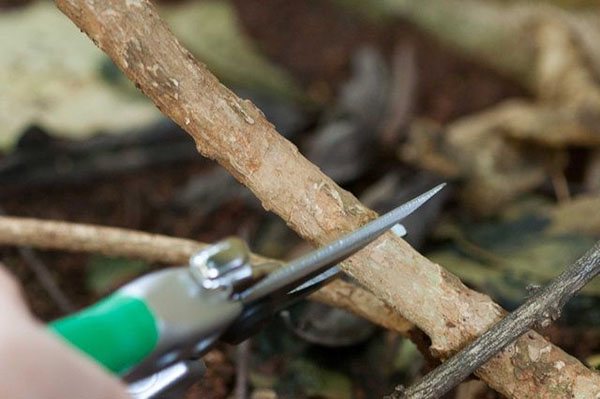

Jasmine is grown for intense garden scent and beautiful delicate flowers. Pruning jasmine in spring has several goals at once:
- improve the appearance of the plant;
- heal and rejuvenate the bush;
- extend the flowering period;
- increase the number of inflorescences and their size.
Removing the long branches of jasmine helps create symmetry or shape. Strongly overgrown bushes are thinned out to get young strong shoots. The ends of branches about 40 cm long are cut off, or they are removed completely at ground level. Shoots over 10 years old must be cut off.
After pruning jasmine, the cuts must be sealed with garden varnish in order to maintain the health of the bush.
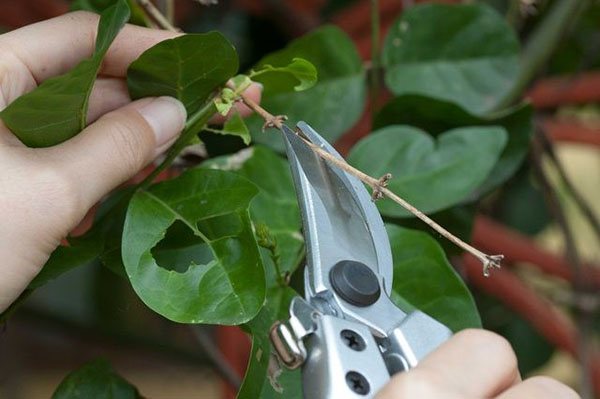

Growing a plant in the garden involves regular maintenance, jasmine is freed from old inflorescences and unnecessary shoots regularly. After winter, frozen branches, roots on the surface of the earth are cut off.
Formative pruning of jasmine in spring will prepare the plant for flowering and increase the number of young shoots that will give it splendor and hide the bare trunks. In the spring, before the plant "wakes up" with pruning shears, cut off old branches flush with the ground or shorten them by a third of their length.
Pruning jasmine in spring will give the plant shape, remove weak and shorten branches that are too long, and allow you to get new shoots that will increase the splendor of the bush.
Over time, the "older" the plant becomes, the more "wild" shoots appear, which do not bear any load, but are actively fed from the roots. This greatly affects the aesthetics and health of the plant. In spring or autumn, unnecessary twigs are removed, the inner space of the bush is thinned out.
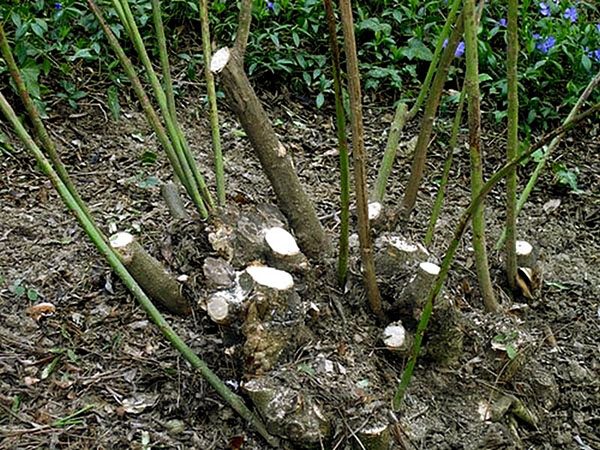

Features of jasmine pruning:
- A primary "haircut" of jasmine is carried out 3 years after landing on a permanent place.
- Spring work begins before the buds appear.
- Two-year-old shoots do not touch, they are responsible for the development of the root system, the formation of the crown and the release of flower beds.
- To obtain a beautiful and high-quality crown, the height of the bush is about 2 meters.
- When pruning, dry, diseased, crooked shoots and branches older than three years without flowering buds are the first to be removed.
- Bushes of seven years and older need pruning for rejuvenation. Leave healthy and strong trunks (1/3) up to half a meter high, the rest are removed at the root, sealed with garden pitch. This provides sunlight and stimulates the growth of new branches. The next year, one third of the old trunks left behind are cut; by the end of the third year, the pruning of old branches should be completed.
- The shoots extending from the ground to the side of the bush are cut off, they are not suitable for the formation of a plant.
How to propagate a chubushnik
For reproduction, plants use one of the 4 proposed methods:
- dividing the bush
- layering
- cuttings
- seeds
The plant tolerates any type of reproduction well and gardeners do not have difficulties with this. Choosing this or that method, you need to know that using the seed of a bush for breeding, the flowering of jasmine can be observed only 3 years after planting.
Reproduction of mock-orange by cuttings
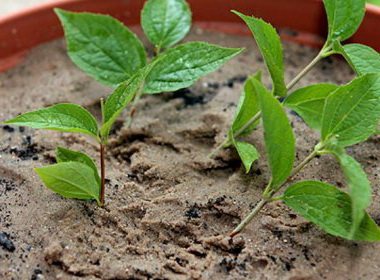

Chubushnik cuttings photo
Chubushnik can be propagated by cuttings in several ways:
- using annual cuttings cut in early spring, before the beginning of the growing season;
- using cuttings cut in the fall.
- green cuttings.
Further actions will depend on which cuttings are used for transplanting.
How to root cuttings cut in the fall
- Cut cuttings are stored until spring. For this, a basement is used, where a zero temperature is maintained.
- With the onset of spring, prepared cuttings are placed in pits with sandy soil. In this case, a pair of upper buds should remain above the ground.
- A full-fledged root will be formed by autumn.
- The next spring, when the stalk is out of dormancy, it is pruned. They do this in order to give a course to the development of young growth.
- In the fall, an already fully formed young bush is transplanted to a permanent place specially designated for it.
How to root cuttings of garden jasmine, cut in spring video
- Cuttings are cut only from the healthiest and strongest branches. As for their length, approximately 6 - 8 centimeters is quite enough. Each cut should have a pair of leaves and an internode.
- To form a root in such a cutting, it is placed in greenhouse conditions, planted in prepared soil rich in humus, turf and sand.
- Deepening of the cutting - 1 cm.
- After planting, the cutting is sprayed several times a day. They do this so that it takes root faster. Approximately, the rooting period of the cuttings is 2 - 2.5 months.
- Hardening a young plant is one of the important stages after the rooting of the cuttings. To do this, they begin to open the doors of the greenhouse in the evening. For the winter, hardened, with a formed root system, cuttings are dropped in the open field from the leeward side.
The cuttings are transplanted to a temporary place by May, and the plant can count on a permanent place of growth only after three years.
Reproduction of chubushnik by layering
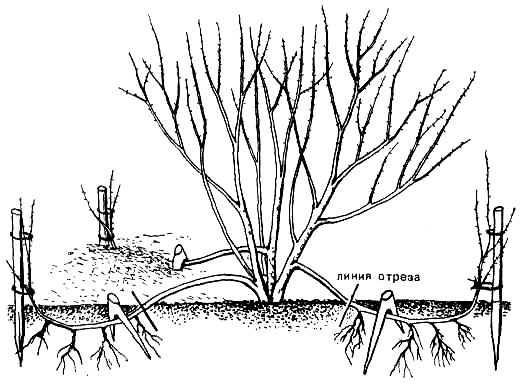

How to propagate a chubushnik by layering
In order for the process of reproduction of the mock-mushroom to be successful by the layering method, the most beautiful and healthy bushes are selected in advance, cutting them to the ground in the spring. Instead of old branches during the growing season, young flexible and pliable shoots will begin to emerge.
The next spring, before the first leaves appear, a bundle of wire is applied to the flexible stem at a distance of 1 cm to the lower bud. After thickening, the stem takes root. They become part of a single root system of a new bush. As soon as the first signs of stem rooting appear, it is tilted and sprinkled with nutritious soil.
During the season, they spud a couple of times and do not forget about watering. You should start separating this stem of the mock-orange only with the onset of the calendar autumn. Make sure that it is well rooted and has new shoots. It is better not to transplant it immediately to a new place, but to arrange it on a temporary bed so that it becomes strong and hardy. In a couple of years, the chubushnik will be ready for transplantation to a new (permanent) place.
How to propagate garden jasmine by dividing a bush
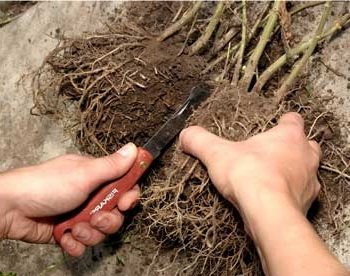

Reproduction of chubushnik by dividing the bush photo
Large jasmine bushes cannot be handled with this type of propagation. A young shrub will work very well. It is not difficult to remove it from the ground and do all the operations for dividing the bush.
At the first stage, the bush is dug up and carefully freed from the clods of earth so that it is clearly visible in which place it is preferable to divide it. It is important to carry out this procedure correctly, even if the bush is not divided in half. Look more at how the root system develops. When dividing, they try not to harm the plant.
It is better to deal with dividing the bush in the autumn (for the middle lane, this is October). Some experimental gardeners are not averse to dividing the bush in the summer. This is also possible. Just make sure that these manipulations do not coincide with the flowering period of the plant. Despite the fact that the transplantation takes place in the hot summer season, new jasmine bushes are still planted in sunny places in accordance with the requirements of the plant itself.
Growing a mock-orange from seeds
Chubushnik seeds of garden jasmine photo Chubushnik from seeds
And this breeding method requires special knowledge, the right approach, which boils down to the following:
- Purchased or those seeds that were collected on the site after ripening are sown in early spring in late February - early March;
- Before sowing, a soil is prepared, which should contain 3 components: peat chips, sand and humus;
- Seeds for planting are placed in an elastic stocking, lowering it for 3 (or more) hours in a special solution consisting of water and a growth stimulator;
- Then the seeds are placed in sawdust right in this stocking for a couple of days;
- After 2 days, the seeds are removed from the stocking and dried.
- Since the soil in the containers has already been prepared in advance, it remains only to make grooves, slightly moisten the soil and plant the seeds at a distance of 5 cm from each other. Sprinkling peat on top, moisten it again and wait for the first shoots to appear;
- When the first two or three true leaves appear, the plants dive into separate cups and grow on a windowsill or balcony to a height of 20-30 cm.
- Watering should be done in moderation, keeping an eye on the humidity and not allowing the earthen coma to dry out.
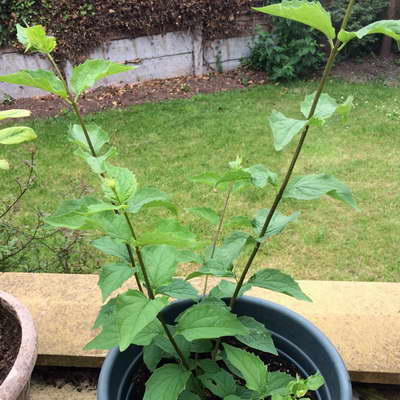

Growing garden jasmine from seeds photo
Before planting in the ground, the seedlings are hardened by taking them out into the fresh air. Gradually, the plants get used to their natural environment and can remain outside painlessly for 24 hours. So you can leave young bushes in a shady place in the garden until autumn. In the absence of the threat of frost, the seedlings are planted in the garden in warm autumn, for the winter they are covered with spruce branches or a thick layer of leaves.
Correct pruning of chubushnik: in spring, after flowering, in autumn
Garden jasmine needs annual pruning to form a decorative crown shape, especially vigorous species and varieties.Otherwise, it will thicken with young shoots and grow ugly.
Sanitary pruning in spring
Before the buds awaken (late March - early April), remove weak and damaged shoots growing inside the bush. If you wish, you can shorten a few of the strongest branches, but proceed with caution as over-pruning can result in no flowering this year.
Sanitary pruning can be done at any time of the year. The full formation of the crown of the bush will be performed after the mock-orange has faded.
Anti-aging pruning
About once every 2-4 years, it is necessary to rejuvenate the plant. In the early vein at the garden jasmine, cut off all shoots older than 10-12 years old at the very base of the bush ("on a stump").
Due to this pruning, the crown of the garden jasmine will rejuvenate and stimulate powerful flowering and growth. New strong shoots will bloom next summer.
"Refreshing" an old bush
A very old or neglected bush is easier to rejuvenate by cardinal pruning.
- At the end of April, cut down all the trunks at ground level, and cut 3-4 of the healthiest ones at a height of 35-40 cm. Treat the cuts with garden pitch, and spread a 4-5 cm layer of humus around the bush and dig a little soil (6-8 cm) ...
- Water the mock-orange regularly and abundantly in the summer. It is also advisable to feed the mullein infusion 1-2 times.
- In the fall, new shoots from dormant buds will appear, but in the spring, 3-4 of the strongest ones will need to be left, and the rest will be completely removed. These most developed shoots are the basis of a young shrub.
Formative pruning of chubushnik after flowering
Formative pruning of garden jasmine is best done immediately after flowering (mid-June) so as not to disturb flowering, as it blooms on last year's shoots.
- First, remove any faded buds. If pruning was not done in the spring or there is a need, then completely remove all weak and damaged branches.
- Then trim the shoots of the current year to last year's growth (green section of the branch to the lignified part). By October, a new growth with lateral shoots will have time to appear on these branches, on which flowers will appear next spring. If you want to reduce the height of the bush, then cut off all or the longest shoots below the growth zone.
- Also prune 4-5 year old shoots growing inward and bare, weakly flowering, to thin it out. And if the bush is very thick, then cut off 20-25% of the old trunks at the base.
Pruning chubushnik in autumn
You cannot prune young shoots of garden jasmine in the fall if you want it to bloom next year. In autumn, if necessary, you can carry out sanitary pruning and thinning of the bush (growing inward and weak shoots).
Diseases and insect parasites
Garden jasmine has a high degree of resistance to various diseases and pests. But sometimes it happens that the following insects strike him:
- Aphid... To destroy the pest, use Karbofos or Rogor.
- Spider mite... This insect can be dealt with with a 3% Keltan emulsion or a 2% Phosphamide solution. Processing is carried out several times at intervals of a week.
- Green leaf weevil... For the extermination of weevil larvae and beetles, Chlorophos is used for spraying.
Sometimes budding gardeners wonder why garden jasmine doesn't bloom. The reasons may be a lack of light, water or a lack of feeding. Chubushnik does not bloom due to excessive spring pruning. Planting too deep can cause no flowering. In these situations, it is necessary to correct mistakes in plant care.
Garden jasmine
Chubushnik is an ideal plant for landscaping. With garden jasmine, you can create a dense hedge. In order for flowers to decorate the garden for about two months, you need to make a flower garden from several varieties of shrubs, which differ in different flowering periods.The blossoming shrub flowers fill the air with a pleasant sweet scent that can be enjoyed for hours.
Varieties of chubushnik
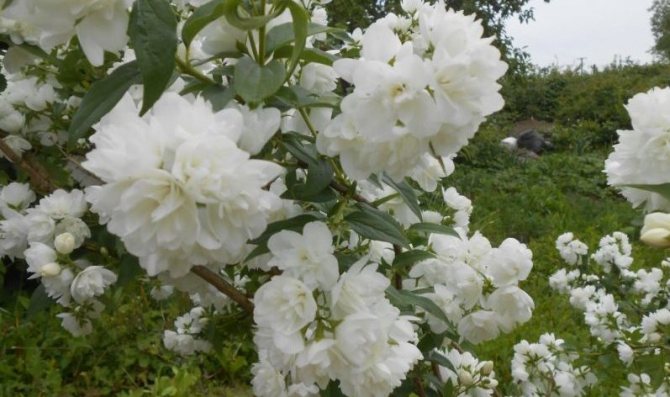

The mock-orange flower is of different types. The following varieties are considered the most popular:
- crown mock-orange grows up to three meters, blooms with white flowers, has large carved leaves. The bushes smell throughout the garden. This variety blooms in June and pleases with its flowering for 20 days;
- the very first to bloom is the Schrenk variety. The bushes have oval narrowed leaves, large, fragrant flowers, which are collected in inflorescences of 9 pieces. This type of chubushnik firmly endures the most severe frosts. Blooms in June and pleases the eye for 25 days;
- small-leaved mock-orange grows low, has flowers similar to cherry flowers. The variety smells like strawberries. The bush is completely covered with flowers during flowering;
- the odorless variety of chubushnik has small green shoots, large leaves, white flowers. The shrub blooms in June and blooms for a month. Sky-white flowers resemble a square with a large number of stamens;
- the tallest bush is Gordon's mock-orange. It can grow up to four meters. The plant has large, glossy, bright green shiny leaves and pure white flowers. The variety blooms in June, emits a delicate weak aroma;
- in a fluffy variety of chubushnik, the lower leaves are airy, the flowers are beautifully shaped, large. The shrub blooms in "cups" in July and pleases with its species until mid-August. The plant grows up to three meters.
There are also breeding plant varieties. The most famous varieties are Airborne Assault and Unusual. The first grade has a height of two meters, a delicate aroma, flowers in the form of a bell. With the help of it, a hedge is often created. The unusual mock-orange grows only up to one and a half meters, has bright purple flowers with an incredible smell of strawberries.
When choosing a variety for your garden, pay attention to the size of the future shrubs. Plants of varying heights can help create beautiful hedges in any landscape.
The following types of mock-orange can be attributed to breeding plants:
- the low shrub variety "Ermine mantle" has semi-double petals. It has flexible, hanging branches. Blooms for 50 days and smells of strawberries;
- the Mont Blanc shrub blooms for a month, has a two-meter growth. Possesses dense double flowers, strong strawberry aroma;
- the variety "Ballet of Moths" has flowers with four semi-double petals, which have a greenish tint and a shape reminiscent of the wings of moths;
- variety "Avalanche" has arched branches, which are abundantly dotted with flowers. Such shrubs are most loved by gardeners;
- The variety "Zoya Kosmodemyanskaya" smells of pineapple. The plant grows up to two meters. Has large double flowers. Blooms for two weeks in mid-summer. Anyone who loves the pineapple smell will always find a place in the garden for this kind of chubushnik.
How to transplant garden jasmine mock-orange
Not only for its powerful snow-white flowering, but also for its good adaptability after transplantation, garden jasmine is appreciated by numerous admirers. For transplanting, plants are used at any time except for the flowering period. If the transplant is carried out in the spring, then this year the jasmine will not delight anyone with its flowering.
When transplanting, the following actions are carried out:
- the jasmine bush is filled with water, in excess, so that it is easier to dig it out of the ground;
- while the soil is soaked in water, pruning is carried out: old branches, including last year's branches, are cut off completely, while young ones are slightly shortened;
- then the bush is dug up and transplanted to a new place.
At least 2 buckets of settled water will be needed to water the transplanted bush. Then the ground around the plant is sprinkled with a layer of humus as mulch.
Chubushnik pruning
Correct care for the chubushnik implies competent pruning... Jasmine flowers appear on annual shoots. From the decorative tapeworm, immediately after flowering, it is necessary to cut off the dried inflorescences and bolls so that the plant develops shoots that will bloom next year.
In the fall, you need to carry out corrective pruning: remove dried, broken, weak branches growing inside the bush. In the same way, you can rejuvenate an old, seemingly hopeless bush: cut off all branches at a height of 25-30 cm.
During the season, caring for the mock-orange includes regular inspection of the foliage, the search for possible pests and diseases. If affected areas are found, they should be cut and burned, the plant should be treated with insecticides or fungicides according to the instructions.


Possible problems
Chubushnik is considered not only a hardy plant, but also very responsive to care. An abandoned shrub will also grow, bloom, bear fruit, but it will reveal all its possibilities if you pay a little attention to it. He will thank you with bright foliage, abundant flowering, and an incomparable aroma.
What does a gardener need to know?
- Choose a suitable planting site, preferably not in the shade.
- The soil must be fertile and breathable. If the shrub grows for a long time in one place, then the soil is depleted, the plant will need organic and mineral feeding.
- Chubushnik does not like moisture stagnation. If the soil is prone to waterlogging, it is required to introduce drainage into the planting hole, its layer should be 15 - 20 centimeters. With prolonged drought, the plant needs watering.


Chubushnik transplant
The garden jasmine shrub is relatively easy to transplant at any age. The optimal time for transplanting adult bushes is from late August to mid-October, but it is also possible in spring in April.
- Water the chubushnik abundantly the day before digging, so that it is easier to transfer it with a clod of earth, and it will stock up on nutrients.
- Cut off young shoots of the current year (autumn) or last year by 30-40% (spring).
- Carefully dig out the bush, plant it together with a lump of earth in a new place and pour 10-15 liters of water.
general characteristics
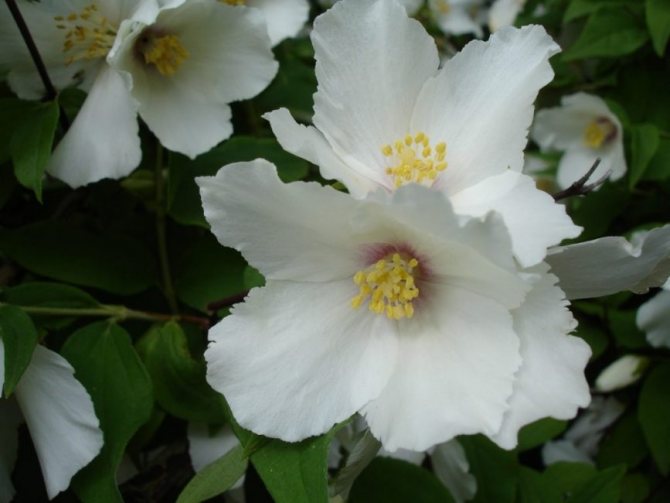

Chubushnik flower
Chubushnik belongs to the Hortensiev family. It is a deciduous shrub, some species are semi-deciduous. Grows in Europe, East Asia and North America.
Many people confuse it with jasmine. You can find the second name - garden jasmine. The confusion comes from the sweet scent of the flowers.
The shrub is named chubushnik, because chubouks for smoking pipes were made from its wood.
Bush height Varies from 70 centimeters to 6 meters. Its stems are covered with gray bark; it is brown in young plants. It is thin, tends to flake off.
Leaves They grow opposite to each other. Their length is 5-7 centimeters.
They can be different in form:
- ovoid
- elongated
- oval
Their edges are either even or have teeth. In different varieties, they are blunt, round or wedge-shaped. The upper part of the leaf is smooth, the lower part is covered with fine down.
Inflorescence Has the shape of a brush. It is formed from 3-9 flowers. They are formed at the tops of the shoots or in the axils of the leaves.
Flowers There are both simple and terry. Their diameter is from 2.5 to 7 centimeters. Their color is white, cream or yellow. Despite the fact that the plant has gained popularity for its aroma, there are varieties with a faint or no smell at all.
Fetus It is a box with seeds. They are very small, so 1 gram can contain up to 10,000 seeds.
back to menu ↑
See also: Gazebos with barbecue and barbecue - (80+ PHOTOS) Drawings of projects that you can implement yourself
Botanical description
Almost all representatives of the chubushnik family are plantations with small leaves and narrow multiple trunks covered with gray-brown bark. They are characterized by an increase in breadth, form tight and dense bushes. Dwarf types do not grow more than 70 cm, tall ones - up to 5-6 m.Known for their rich flowering, snow-white or creamy flowers 3-5 cm in size. Opening in early spring, they give off a sweet scent. Sometimes there are velvet, semi-double and ordinary forms, matched in corollas at the very top.
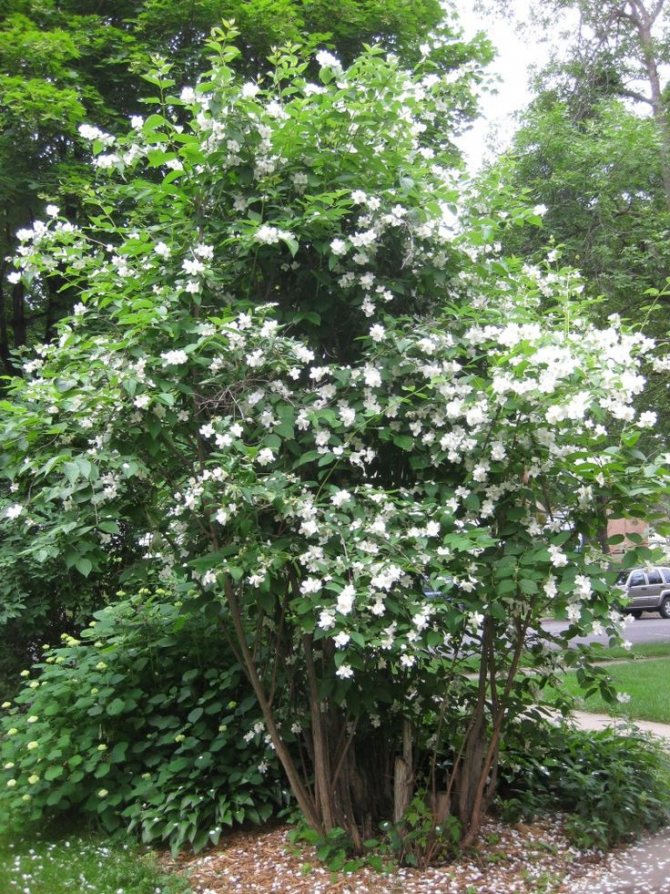

The leaves are small, 2–7 cm in size. Their appearance is different: oval, ovate, elongated, with a round and sharp edge, widened and narrowed, with a flat or serrated edge. Distributed oppositely along the stem, on small petioles. The leaf plate is smooth on top. In autumn, the crown turns yellow. Evergreen types are available.
Fruit in the form of three and five-sided capsules, with seed filling. Semi-inferior pistil, nesting, with accrete columns. In the center there are numerous stamens, on average 50–60 pcs.
the culture is winter-hardy, does not need additional protection. Possesses great resistance to various climatic conditions. Sometimes, after freezing, it can restore strength and dissolve the newest processes.
What varieties are recommended for planting in the garden
Three main varieties of jasmine are grown in the country, which became the basis for breeding many varieties:
- small-leaved;
- coronal ordinary;
- fluffy.


It is best to use jasmine varieties to decorate your own plot:
- Moonlight;
- Dwarf;
- Charm;
- White bouquet;
- Ermine mantle;
- Arctic;
- Pompon;
- Firework;
- Obelisk;
- Charm;
- Kazbek.
Separately, it is worth highlighting the Ermine mantle, in which the flowering period lasts up to 2 months, and the inflorescences are located along the entire length of the branches, which gives jasmine a special decorative effect.
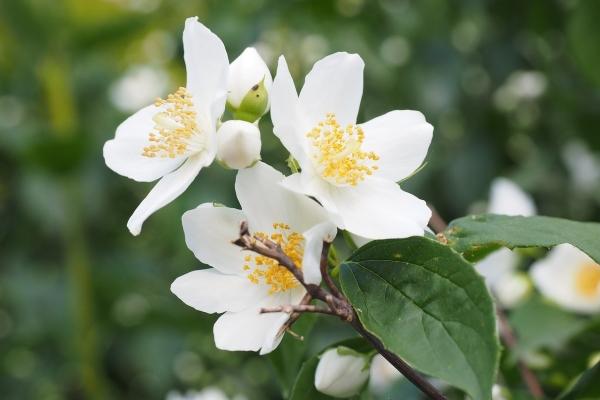

How to care for your culture
It is important not only to plant jasmine on the site, but also to provide it with proper care so that the shrub will please with abundant flowering.
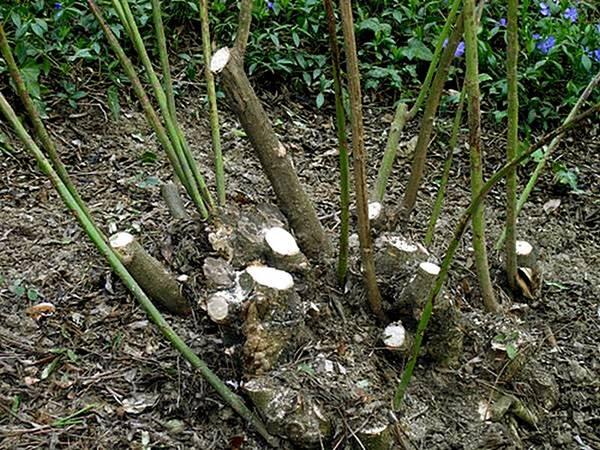

Watering frequency
Jasmine does not require frequent watering, provided it is grown in the middle lane. The shrub is irrigated only in case of prolonged drought and hot weather. The need for moisture is determined by the state of the top layer of the soil and the jasmine itself, the leaves of which lose their elasticity. Up to 30 liters of warm water is added under each plant. In the autumn, before the onset of cold weather, moisture-charging watering is done so that the shrub can more easily endure the winter and not freeze.
Top dressing
Top dressing is required for jasmine from the second year of life. Fertilizers are applied during the entire growing season, using both organic matter and mineral mixtures. In summer, shrubs need more nitrogen, so it is recommended to add urea, superphosphate, and potassium sulfide. Manure and humus are used from organic matter. The recommended dosages should be strictly observed. Otherwise, the shrub will suffer from excess nutrition, will increase its green mass and will not show exuberant flowering.


Loosening and care of the trunk circle
Loosening of the soil in the near-trunk circle of the bush is carried out after each heavy rainfall or watering. Do this carefully and not too deeply so as not to damage the jasmine root system. All weeds are removed at the same time.
Pruning
Pruning is an important part of caring for your jasmine bush. If done correctly, the plant will look aesthetically pleasing, develop correctly and bloom violently.
Formative
Jasmine shaping pruning is more commonly done in early spring. In the fall, it does not make much sense, since during the winter some of the shoots may break, freeze or simply die off. To form a beautiful bush, you need to cut off too long branches, and remove diseased or dried ones altogether. Poorly developed processes are shortened in half to provoke the growth of young branches. This scheme allows you to make the jasmine bush lush, thick and beautiful.
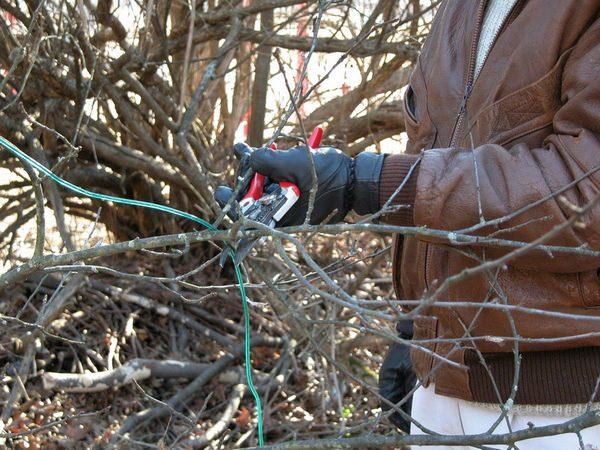

Sanitary
Typically, sanitary pruning is done in the spring. Before budding begins, remove any broken or frozen branches. Shoots with signs of the disease are subject to immediate removal.If the autumn sanitary pruning of jasmine is carried out, then the plant is carefully examined for mechanical damage, the presence of dry shoots or too old shoots, which are best removed immediately.
Pruning jasmine after flowering
Immediately after the end of the flowering of the jasmine bush, it is examined and, if necessary, pruning is carried out. Dead inflorescences, weak and diseased branches are removed.
Rejuvenating
Over time, the jasmine bush grows old and loses its attractiveness. Bare shoots not only spoil the view, but also impede the growth of young twigs. As a result, flowering is not so exuberant. In this regard, the plant needs a rejuvenating pruning once every few years. Work is carried out in the spring, before bud break. Choose 4 or 5 attractive stems and shorten them by 50% of the length, the rest are simply cut at the root.
See also
Planting and caring for lupines in the open field, whether it is necessary to cut them for the winterRead
The cut sites are treated with garden varnish. With the beginning of sap flow on the stumps, buds will wake up and give new shoots, from which several of the strongest are selected. It is they who will form the crown of the renewed jasmine.
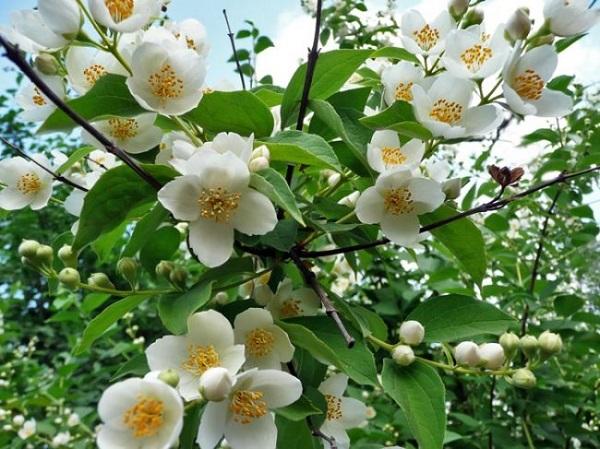

When to transplant to a new location
Transplanting a jasmine bush to another place is rarely done, in case of emergency. The reasons for this may be various, for example, closely growing trees began to block the access of light to the shrub. There is a debate among gardeners about when to replant the plant so that the stress for it does not turn out to be too strong. Most agree that the work should be planned for the spring. The procedure itself is not much different from the usual planting of jasmine on the site.
To transplant it to a new place, it is necessary to dig a planting hole, which will correspond in volume to the root system.
It is preferable to dig out the bush together with a lump of earth and not shake it off when transplanting.
Treatment and treatment of diseases and pests
The jasmine bush is most often affected by pests such as:
- weevil;
- spider mite;
- aphid.
As a result of their impact, the shrub loses its decorative properties, ceases to develop normally, its foliage curls up into a tube. At the initial degree of damage, the leaves of the plant are removed along with the pests and burned, and the jasmine is treated with a solution of laundry soap. In case of severe damage, insecticides are used.
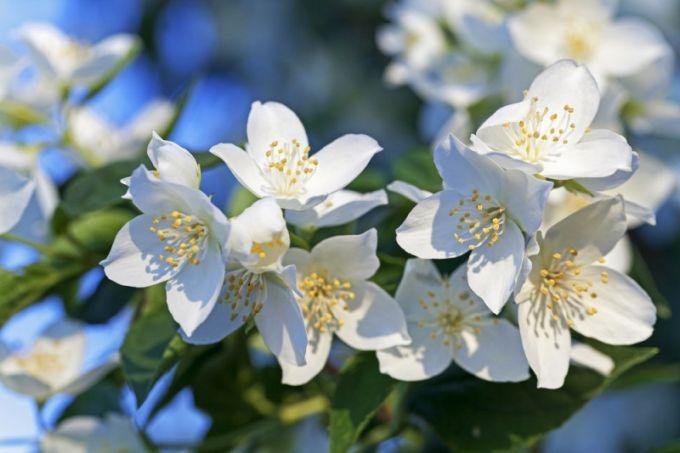

Jasmine is highly resistant to disease, which is most often due to lack of nutrients. For prevention purposes, it is recommended to apply complex mineral fertilizers.
Preparing a shrub for winter
In order for a garden jasmine to easily endure the winter outdoors, it will need proper and good preparation. An adult shrub tolerates the cold season better than a young one, therefore it does not need special preparation and insulation. Immediately after the end of the flowering period, young specimens are covered with a specially designed material or ordinary straw is used. The soil in the near-stem circle of the bush is dug up and compost is introduced into it.
The difference between jasmine and chubushnik
Chubushnik is sometimes called jasmine. But these two plants are completely different. Jasmine is similar to mock orange only in that it has a similar shape and color of petals.
The main features of the chubushnik:
- garden mock-orange and other plant species bloom throughout the summer. There is a variety that blooms for 50 days. Other varieties bloom within three weeks;
- chubushnik blooms only in white shades. It is very rare to find varieties with small pink spots at the very beginning of the petal. Jasmine blooms in different shades;
- the chubushnik bush is abundantly strewn with flowers, due to which their appearance resembles a white cloud;
- it is chubushnik that always saturates the garden with a strong aroma. There are shrub varieties that smell like strawberries or pineapple.
The bushes with small flowers are considered the most fragrant. Larger flowers do not smell as strong. There are also varieties that don't smell at all, but they look amazing.
What, how and when to feed the chubushnik
Only once a year, in late spring, one bucket of diluted slurry infusion is introduced under the jasmine bush. To do this, take 1 part of the slurry and 10 parts of water. Starting from the second year, in addition to manure, fertilizing with mineral fertilizers is connected.
It includes:
- urea, in the amount of 15 g,
- potassium sulfate - 15 gr
- and superphosphate in the amount of 20 grams.
All these components are bred in a bucket of water, which is enough to feed 2 adult plants. This procedure is recommended to be carried out annually with the beginning of the growing season, in the spring. After the flowering of jasmine, urea is excluded from the top dressing, while wood ash is added.
In a bucket of water they dilute:
- 15 grams of potassium sulfate,
- 30 gr superphosphate, wood ash 100 gr.
- This solution is enough for 1 m² of land.
Landing in the ground


To decorate the site, select a variety that meets the purpose:
- hedge;
- lawn decoration;
- decoration of gazebos.
Jasmine height varies from 1 to 3 meters. Vines grow like a vine. The plant feels great on a trellis or trellis terrace.
Timing
Planting jasmine in open ground is recommended in spring when the weather is stable or in September, so that the bush, receiving appropriate care, has time to take root for the upcoming wintering.
The plant will experience less stress if the dropping is done in the evening, in rain or cloudy weather.
It was noted that planting jasmine in spring is more preferable, the probability of frost is reduced and there is enough time for rooting. It is important to transfer the seedling to the ground before the first leaves bloom, otherwise it is vulnerable and may die.
Seat selection


The soil at the shrub planting site needs well-drained, moist and moderately fertile. Jasmine needs sunshine for at least 4 hours a day, with long-term illumination, flowering will be abundant and long. Shrubs planted in the shade develop the crown worse, flowers are rare and small.
Each plant needs a minimum of 3 meters of space for healthy root development and crown formation for upright plants. When creating a living fence, bushes are placed every 50 cm.
The life cycle of jasmine is at least 10 years, so carefully choose the place where the bush will be planted.
Pit preparation
Before planting jasmine in spring or autumn, prepare a pit. The depth of the pothole is up to 70 cm, the width is up to 60 cm. A layer of drainage of sand and gravel (20 cm) is poured onto the loose bottom. It takes several days to withstand the pit in this state for warming up by the sun.
When planting jasmine, the roots are covered with soil, which includes:
When choosing a jasmine variety, consider its flowering period. Some shrubs are in bloom from June to August, others from April to June.
Sapling planting process


The crucial moment on which the future state of jasmine depends must be carefully prepared:
- The prepared earthen mixture is poured into the dug hole to form a mound.
- Examine the root system of the seedling. Dry, damaged processes are removed with pruning shears.
- The roots are laid out on the surface of the earth and buried. The root collar is at ground level; it is unacceptable to lower it into the ground by more than 3 cm.
- They pour in the earth and compact the hole.
- Pour water at the rate of 2 buckets of water per bush.
- Sprinkle with mulch to retain moisture and prevent weed growth. Use needles, peat or sawdust.
Features and uniqueness of garden jasmine
Jasmine is native to the Mediterranean, where it is used as a medicinal plant. In our country, the shrub is most often grown for the purpose of decorating a certain territory.A beautiful and lush crown, decorated with large white inflorescences, instantly attracts the eye. And the alluring sweet aroma does not leave indifferent even the most demanding gardener. Jasmine quickly adapts to weather conditions, which is another of its benefits.
The uniqueness of the plant lies in the fact that during their blooming, the flowers contain a huge amount of essential oils that have a beneficial effect on the human body. The bush buds are used both for medicinal purposes and as an additive to black and green tea to increase immunity, cleanse from toxins. Thanks to its healing properties, jasmine is not only an excellent decoration for the site, but also helps to improve health.
How to plant a chubushnik correctly
Garden jasmine is grown as single or group plantings, as well as for creating hedges. For single specimens, a planting hole is dug 50x50 cm in size and 60 cm deep, for a hedge, the distance between the pits is left 0.6-0.7 m.In group plantings of garden jasmine, the distance is increased to 1.5 m.When calculating the distance, it is important to take into account the features of a particular varieties - tall or undersized mock-orange will grow in the garden. Saplings are planted before the leaves bloom, otherwise they may not take root and die.
When to plant chubushnik
Chubushnik is planted in early spring - in the middle or last decade of April, as well as in autumn - from mid-September to mid-October. Autumn planting is suitable for southern regions with a mild climate and not severe winters. However, garden jasmine seedlings planted in autumn show the best survival rate. Work on planting a mock-orange in spring and autumn is no different from each other. The main thing is to observe the planting dates so that the root system of garden jasmine can quickly adapt and get stronger. In the spring, planting is carried out at least 2 weeks before the onset of stable heat - until the buds have blossomed. In the fall - at least a month before the cold weather, so that the root system of the mock-orange can take root in a new place and successfully overwinter.
Where to plant a chubushnik
The scheme for planting a mock-orange depends on the landscape project, but in order for the shrub to look like in the photo above, you need to choose a well-lit, sunny place. On the north side, the site should be protected by a wall of a house or building, a fence, a fence or large trees. The ideal option would be the southern side of any building, protected from cold northerly winds, surrounded by other floral and perennial crops. Ornamental jasmine feels good on a small hill, where the groundwater is very deep.
Important! You can not plant a mock orange in a lowland, where rain, melt water stagnates and accumulates: the root system of the bush will simply rot. The occurrence of groundwater should be at least 150 cm from the surface of the earth.
What can be planted next to a chubushnik
Any flowering shrubs, perennials and annuals will be good neighbors of the chubushnik. Compositions of garden jasmine with spirea, weigela, hydrangea, lilac, decorative apple tree look great. Next to the imaginary jasmine, you can also plant any tree species with unusual leaves or crown - maple, hazel, dogwood, which will become an excellent background for a lush blooming mock orange. In flower beds and flower beds, the mock-grass gets along well with any flowers: annuals or perennials, deciduous and ornamental plants. The composition with roses, peonies looks incredibly gorgeous, the bright beauty of which harmoniously emphasizes the delicate, romantic bloom of the mock-orange.
In addition, in landscape design, garden jasmine is used to decorate alleys or design a thematic garden, as well as for a symmetrical geometric pattern in a specific area of a personal plot.If you follow all the recommended measures when planting and caring for a shrub, a chubushnik surrounded by other flower crops will look the same as in the photo.


What kind of soil does chubushnik like
Regardless of the timing of planting the chubushnik - in spring or autumn - for successful cultivation, it requires fertile, loose soil. To prepare a fertile mixture, mix leafy earth, humus and sand in a ratio of 3: 2: 1. A drainage layer is required, which can consist of sand, crushed stone or broken brick, since the root system of garden jasmine is not resistant to rot formation.
How to plant a chubushnik
After preparing the soil and planting pits, they begin to plant the chubushnik. At the bottom of the pit, drainage is poured with a layer of at least 20 cm, then a small part of fertile soil. The seedling is set so that its root collar is at ground level. Its slight deepening is allowed no more than 2 - 3 cm. If you do not follow these standards, the roots will soon rot.
Important! It is better to plant chubushnik seedlings in cloudy weather or in the evening, avoiding direct sunlight at this time, which will not contribute to good survival.
Reproduction
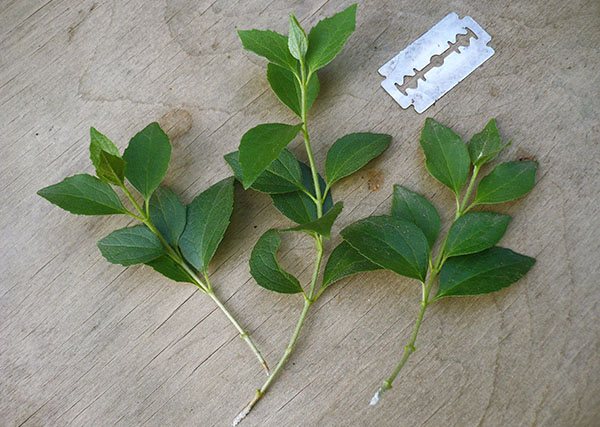

Jasmine can be grown from seeds, cuttings and cuttings.
If you want to get a beautiful jasmine shrub with white flowers as early as possible, choose simple solutions: layers and cuttings.
It is ineffective to plant jasmine seeds in the ground if you strive to get a sea of fragrant flowers on the bush. Flowering is possible only after 7 years. It is easier to use the layering technique, in which a full-fledged copy is obtained with a high degree of probability.
Jasmine propagation by cuttings in spring is the most popular way to teach a new plant, which does not require human energy consumption. Lateral shoots with inflorescences are cut off, shortened to 5 cm, but make sure that there are at least two internodes and two pairs of leaves on the branch.


For planting and subsequent care, you can get roots on a cutting of garden jasmine by keeping it in settled water for about 2 weeks, or in a sand-peat mixture. Cuttings are buried in the ground at an angle, then covered with plastic containers or polyethylene to maintain constant humidity and temperature.
For the development of the root system, the soil is regularly watered and loosened. At the end of summer, a new instance of jasmine will be ready, which is planted in a permanent place in the fall.


Before propagating a jasmine shrub, look at photos of different varieties. Perhaps it makes sense in planting and caring for other species on the site, which will differ in the size of flowers, color and height of the bush.
Bloom
Garden jasmine is most attractive when fragrant flowers open up. It is for its pleasant, sweetish and powerful aroma that most flower growers love it.
The smell of chubushnik has a beneficial effect on the human psyche and raises the mood. The plant usually blooms in the 3rd year after planting.
Blossoming time of the chubushnik
The flowering period of garden jasmine depends on its type and variety. In the conditions of the Moscow region, the crown mock-orange and garden forms based on it are the first to bloom: golden (aureus), dwarf and variegated. They bloom almost immediately after common lilac (the beginning of June).
In the first two weeks of June, the small-leaved, thin-leaved mock-orange, Shrenka, blooms. In early - mid-July, odorless, grayish, broad-leaved and fluffy mock-orange begins to bloom (it blooms later than everyone else).
Duration of flowering averages 20-25 days, in a shady place a little longer. Schrenk's mock-orange blooms the longest, and, for example, Gordon's mock-orange is able to bloom a second time in the fall.
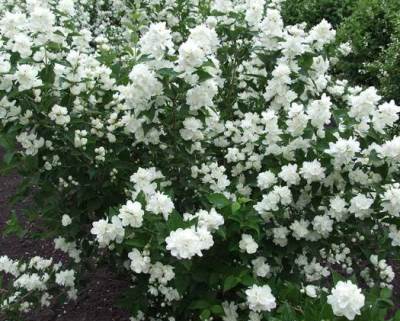

Chubushnik "Zoya Kosmodemyanskaya"
Why is the mock-orange not blooming? What to do?
Garden jasmine may not bloom in some situations.The most common reasons are: lack of lighting (growing in the shade), lack of moisture or nutrients (watering, feeding), unsuccessful wintering (freezing of annual shoots), over-pruning in the spring or too deep planting.
Perhaps the mock orange does not bloom due to its age, especially if you grew it from seeds (7-8th year) or from cuttings (4-5th year).
Types of chubushnik with description and photo
Gardeners fell in love with the following types of this culture, which have become very popular when decorating summer cottages:
- Jasmine virgin;
- Crown chubushnik,
- Chubushnik Lemoine.
Any kind of snow-white mock-orange can decorate a garden plot, create a festive atmosphere. As for planting and caring for a plant, it will not be difficult because of its absolute unpretentiousness.
Philadelphus coronarius
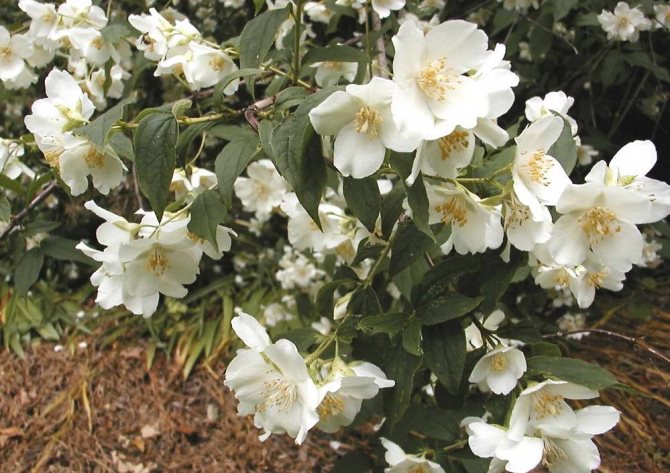

Philadelphus coronarius photo
The crown mock-orange is also called the common mock-orange. The maximum height that a plant can achieve is 3.5 m, while it grows up to 2 meters in diameter. On the reddish shade of the shoots are light green pointed leaves.
Somewhere at the end of May, the mock-orange dissolves its flowers and pleases the eye for 1 month. The five-petalled flowers have a creamy shade, a very pleasant aroma. Not pretentious, grows on any soil, is resistant to gusty winds, does not freeze in severe frosts. Very often, an ordinary chubushnik is used by designers when decorating a landscape.
Chubushnik virginsky or maiden Philadelphus x virginalis
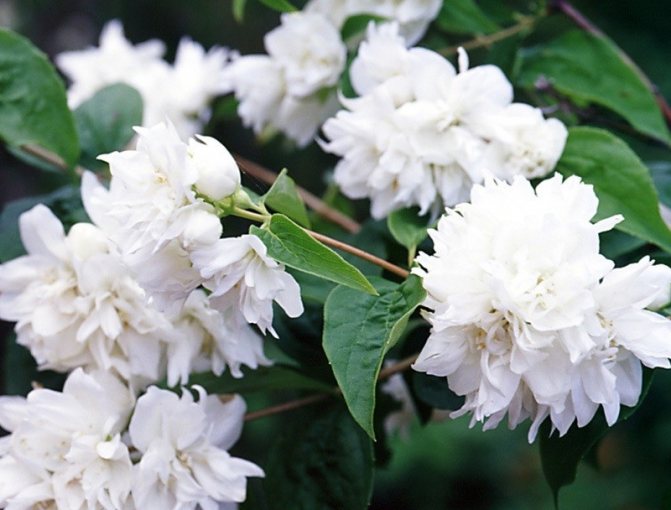

Chubushnik virginsky philadelphus x virginalis ‘minnesota snowflake’ photo
Virginia jasmine is obtained by crossing the small-leaved and evergreen mock-orange species. In garden plots, it grows up to 3 meters high. Oval leaves, 7-8 cm long, together with brown shoots form the crown of a shrub. From the middle of summer, it begins to bloom, releasing snow-white inflorescences consisting of flowers with a double petal type. Flowers reach 5 cm in diameter. Under favorable circumstances, at the beginning of September, the second flowering of Virginia jasmine for the season is observed.
Philadelphus × lemoinei
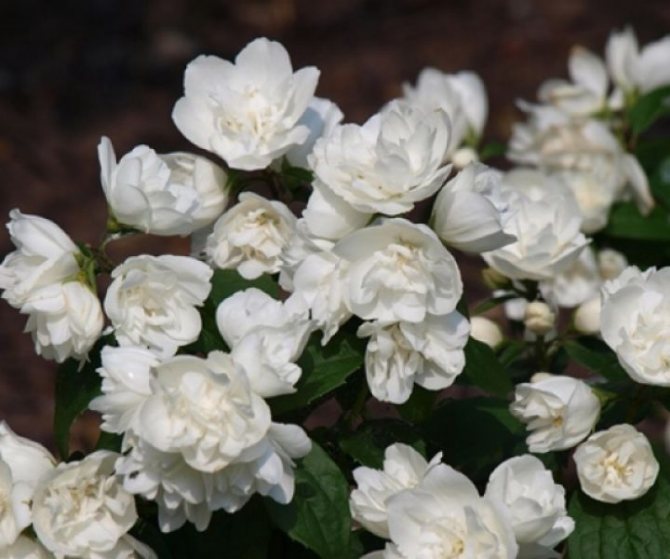

Philadelphus lemoine mock cloak × lemoinei photo
Chubushnik Lemoine differs from its counterparts in that it has small ovoid leaves. The crown of the bush is dense, spreading. Reaches up to 2.5 meters (diameter). The flower petals are terry at the end. One gets the impression that with the onset of the flowering time of the chebushnik lemoine, which falls on the month of June, its leaves begin to hide behind the snow-white flowers. A huge white ball is formed, which some time ago was completely green. For jasmine of this type, it is characteristic that it can also be two-colored. A purple-pink core with golden stamens peeps through its snow-white petals.
Planting technology
The health and further development of the shrub depends on the correctness of the planting work. Jasmine will delight you with exuberant flowering only if agricultural technology and all the rules for planting on the site have been followed.
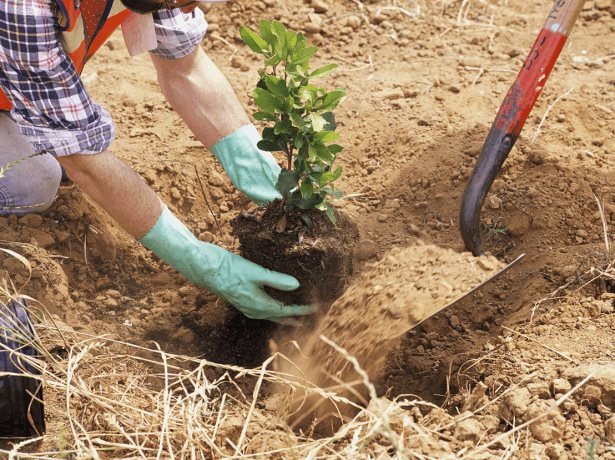

Selection and preparation of a seedling
Shrub planting material should be purchased only in the spring at reputable retail outlets or taken from friends who can be trusted and not doubt the quality, as well as the varietal affiliation of the seedling. For planting, it is preferable to take jasmine with open roots and unblown buds. If leaves have already begun to appear on it, then the chances of settling down are reduced to almost zero.
For planting, it is better to give preference to a shrub 1-2 years old. In this case, its root system is already sufficiently developed, but it is less likely to be damaged when excavated.
Jasmine should not show signs of disease, pest damage or mechanical damage.At the point of sale, the root system of plants should be dug in or covered to prevent drying out.
Terms and technology of planting works
It is recommended to plant jasmine exclusively in spring. The planting hole is dug 0.5 m deep. Its width is about the same, but the exact size depends on the dimensions of the root system of the shrub. A distance of about 10 cm is left from the edges of the pit to the root, and the root collar does not deepen by more than 3 cm.
See also
Description of the best varieties of netted irises, planting, cultivation and careRead


At the bottom of the prepared hole for planting jasmine, a drainage layer of sand, expanded clay and small stones is poured to prevent stagnation of water. It is advisable to add a small amount of nitrophosphate to the soil mixture so that the seedling gains strength faster. Part of this mixture is poured over the drainage in a mound, then the jasmine is installed and the roots are carefully straightened. The hole is covered with the remaining nutrient earth, tamped and watered abundantly. After that, mulching of the periosteal circle is carried out.
If several jasmine bushes are planted in the open field, then a distance of at least 1 meter is left between them. The exception is dwarf varieties, which are allowed to be planted at a distance of 0.6-0.8 m from each other.
Why the mock-orange does not bloom Pests and diseases
Among the pests that can spoil the appearance of jasmine, the most common are spider mites, aphids, and leafy green weevils. You can get rid of them with insecticides. During the spring and autumn processing of the bush, it is best to use karbofos in accordance with the instructions.
Chubushnik may not bloom for the following reasons:


Why the mock-orange garden jasmine does not bloom what to do
- The wrong place for the growth of the shrub was chosen. Shady places negatively affect the plant and should be transplanted.
- The soil does not meet the requirements, the land is severely depleted. Dig up and transplant the jasmine bush into the soil necessary for its normal growth and flowering. Only fertile air-permeable soil, with timely feeding with mineral components, organic matter will be suitable.
- Jasmine does not like strong waterlogging. In areas where it is too damp, it is not recommended to plant a chubushnik. Installing a good drainage system to drain water from the ground will be the ideal way out of this situation. Sometimes a thick drainage layer of 15-20 cm, in a pit for planting a crop, helps to cope with this problem.
- Top dressing of the bush is not carried out according to the rules, an excess of nitrogen is introduced. If you follow all the requirements, the problem will disappear by itself.
- Both over-watering and lack of moisture greatly affect the condition of the plant. During the period of drought, additional watering of the crop is organized, otherwise the plant will not only not bloom, but may also die.
- When planting or replanting a shrub to another place, make sure that the root collar is not buried more than 2 cm.Otherwise, it will underpin, which will lead to its decay and, as a result, the plant growth will be inhibited.
Landing
In order for jasmine bushes to develop well and please with abundant color, it is necessary to correctly determine the planting site.
Garden jasmine should in no case be grown in a lowland, this plant does not tolerate stagnant melt water. Whereas a slight shading does not threaten this shrub with a loss of decorativeness.
Chubushnik prefers well-drained fertile soil. Before planting, they dig up the earth and form holes about half a meter in diameter. The depth and width of the pits can be varied so that a distance of 10 cm remains between the root system of the seedlings and the walls of the holes. The distance between the bushes should be at least 1 m for low-growing varieties of jasmine and 1.5-2 m for taller representatives of this plant.


Before planting, add 2 tbsp to each hole. l.nitrophosphate, and then place a seedling and cover the pit with earth. The deepening of the roots of the neck by 2-3 cm is allowed. The ground around the plant is lightly tamped and watered abundantly with warm, settled water.
In order to accelerate the survival of jasmine, it is recommended to plant it only on cloudy and cool days, and after planting, the plant trunk circle is mulched with a layer of peat or pine bark 4-5 cm thick.
What to consider when growing
Jasmine is not a capricious shrub, but it has certain growing characteristics that must be taken into account when planting a plant.
Required soil composition
Almost any soil that has a sufficient supply of nutrients is suitable for planting jasmine. The root system of the shrub does not tolerate waterlogging, therefore the groundwater level should not come too close to the surface. If there is not enough nutrition in the soil, then this will affect the beauty of flowering.
The optimal composition of the nutrient soil for ornamental shrubs is a mixture of humus and river sand (1 part each), as well as sod land (2 parts).
Requirements for illumination of the place
If you have to choose where to plant jasmine on the site, then preference should be given to a well-lit place. The shrub also feels good in partial shade, but in such conditions it is impossible to achieve lush flowering.
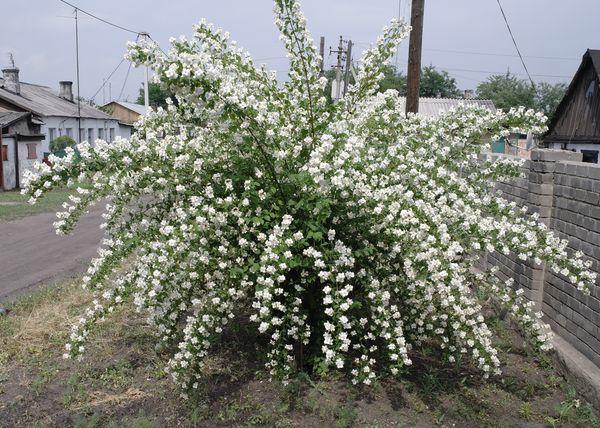

Suitable and unsuitable neighbors
Jasmine is best planted next to dark blue or purple flowers. Good neighbors for the bush will be:
- delphinium;
- lavender;
- hydrangea;
- spirea.
You can not plant jasmine near apple and pear trees, since these fruit trees suffer greatly from such a neighborhood.


